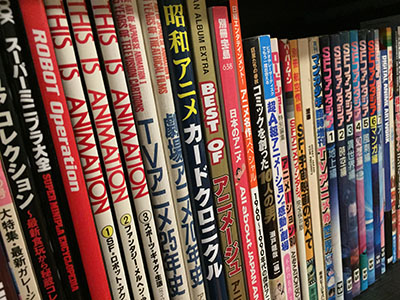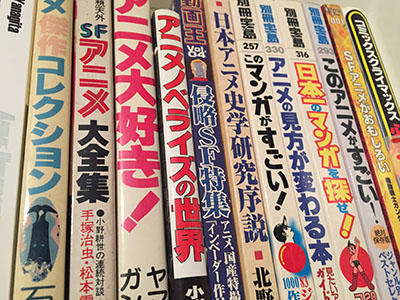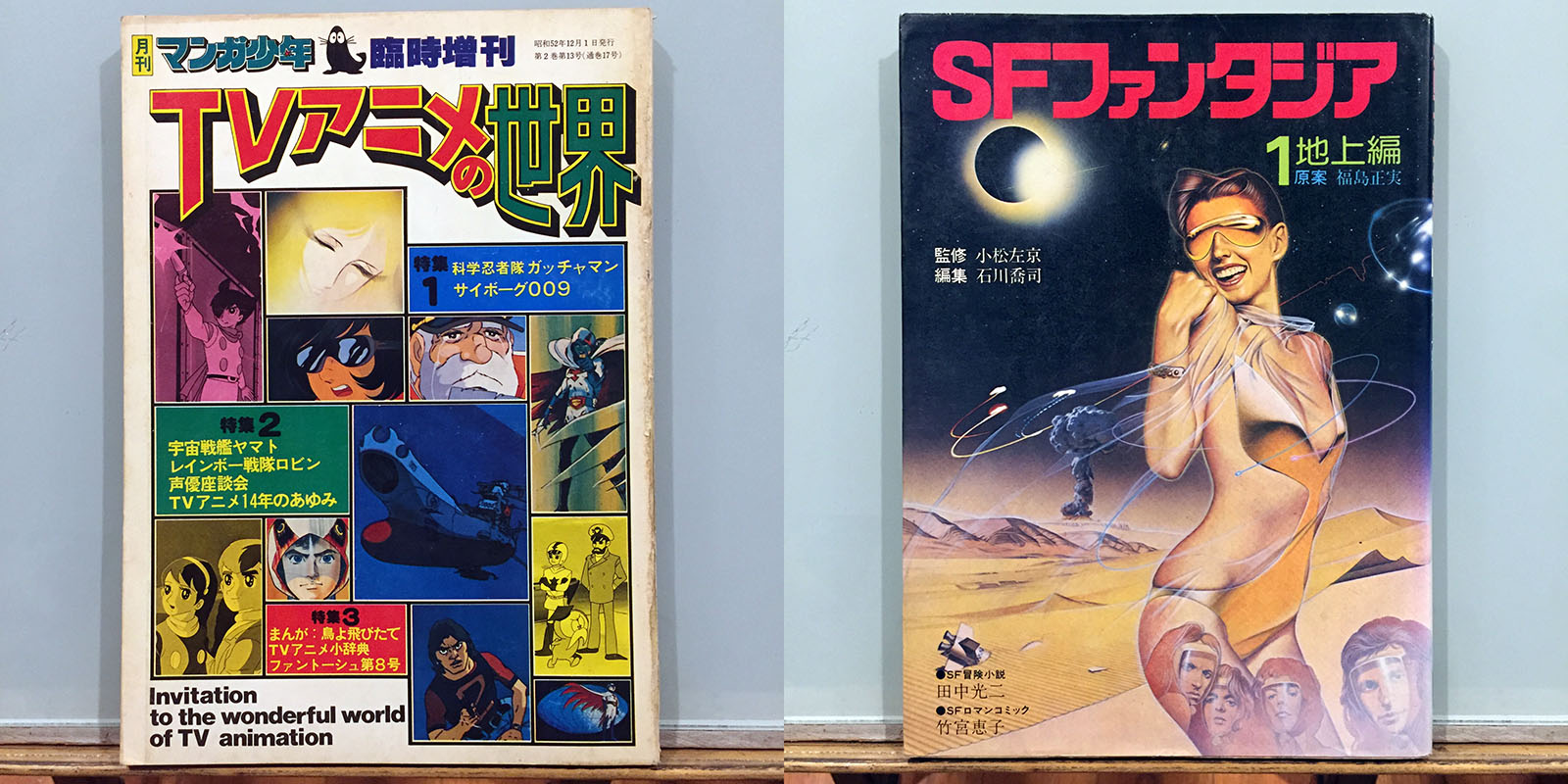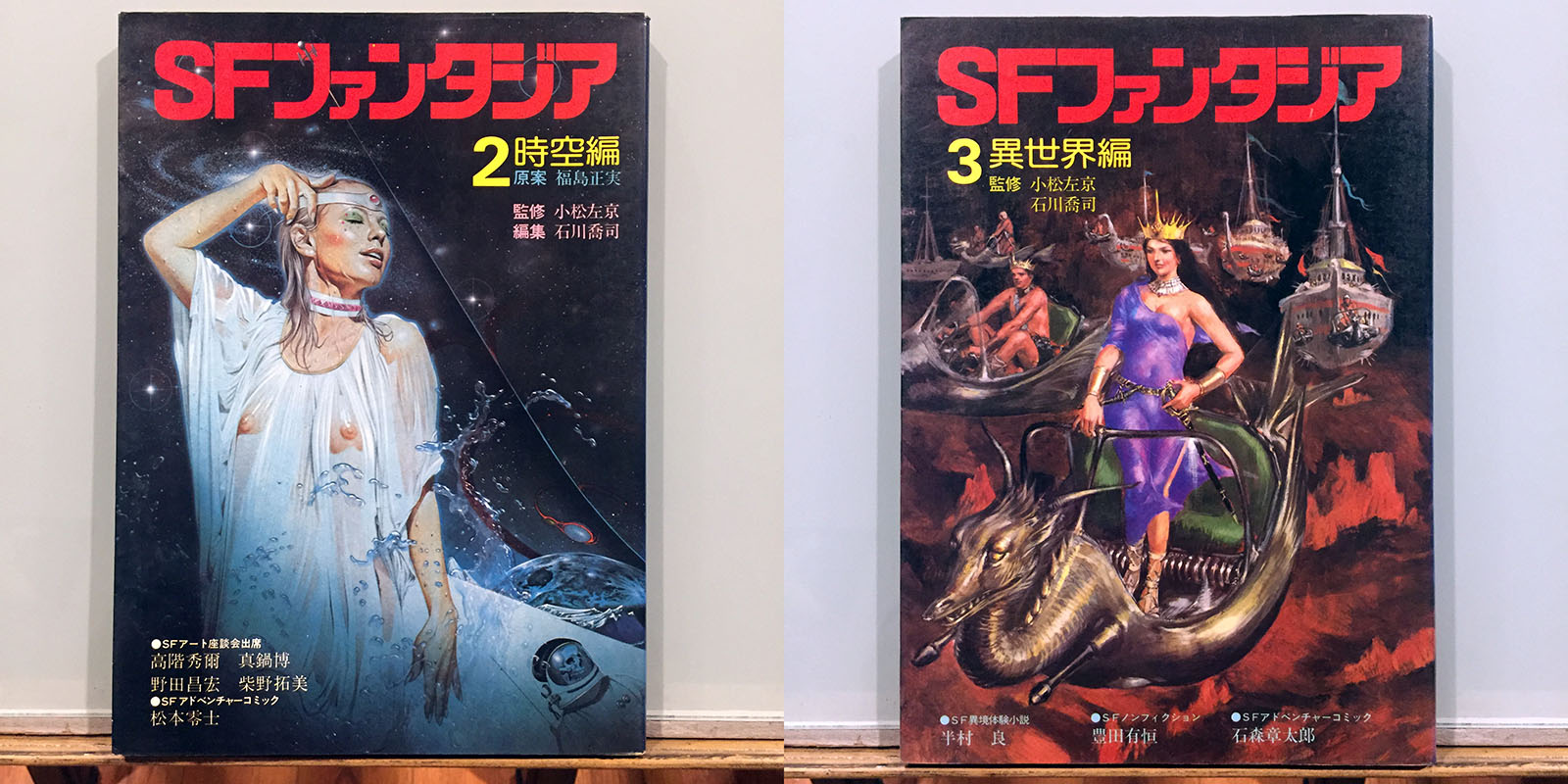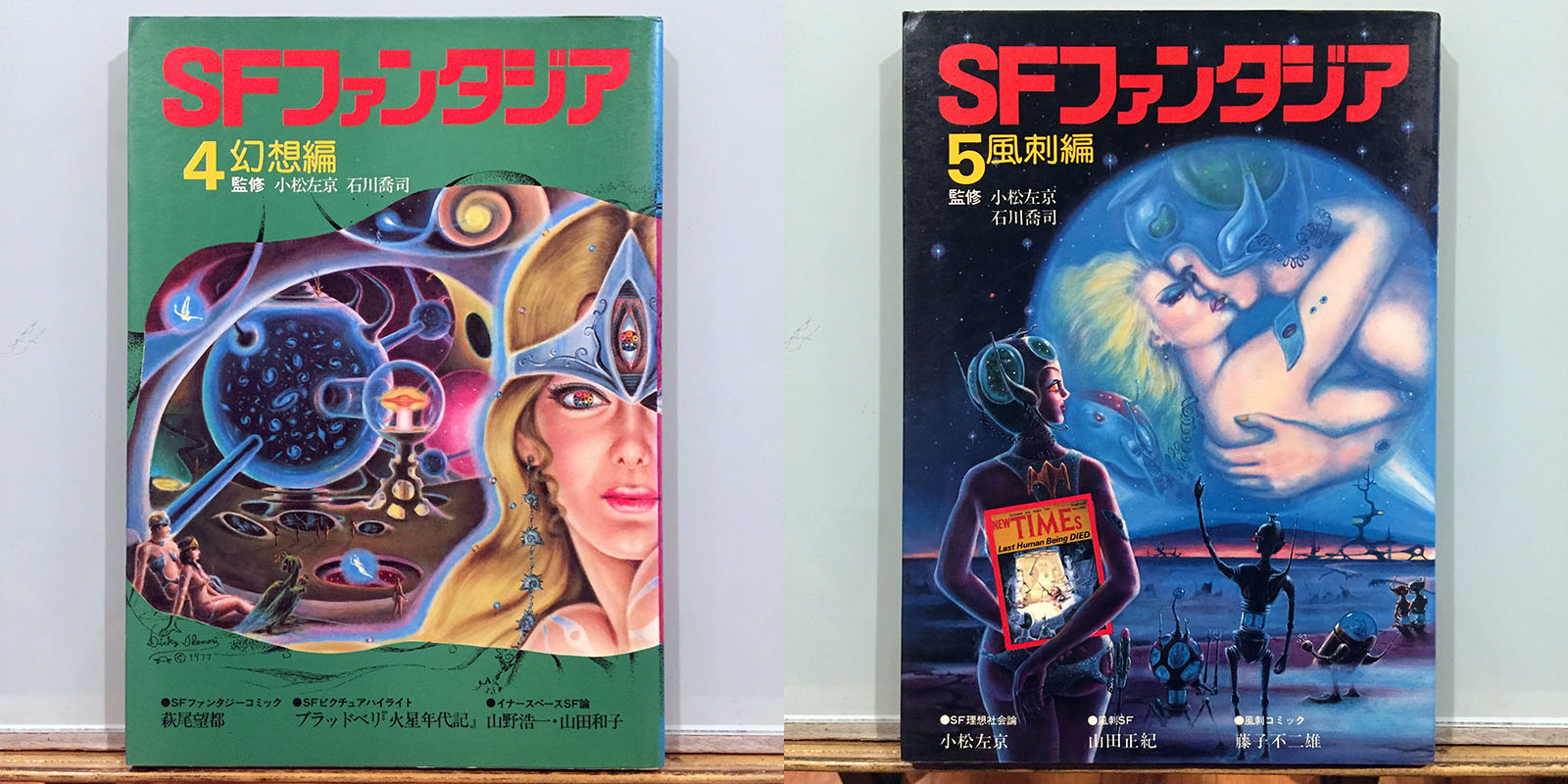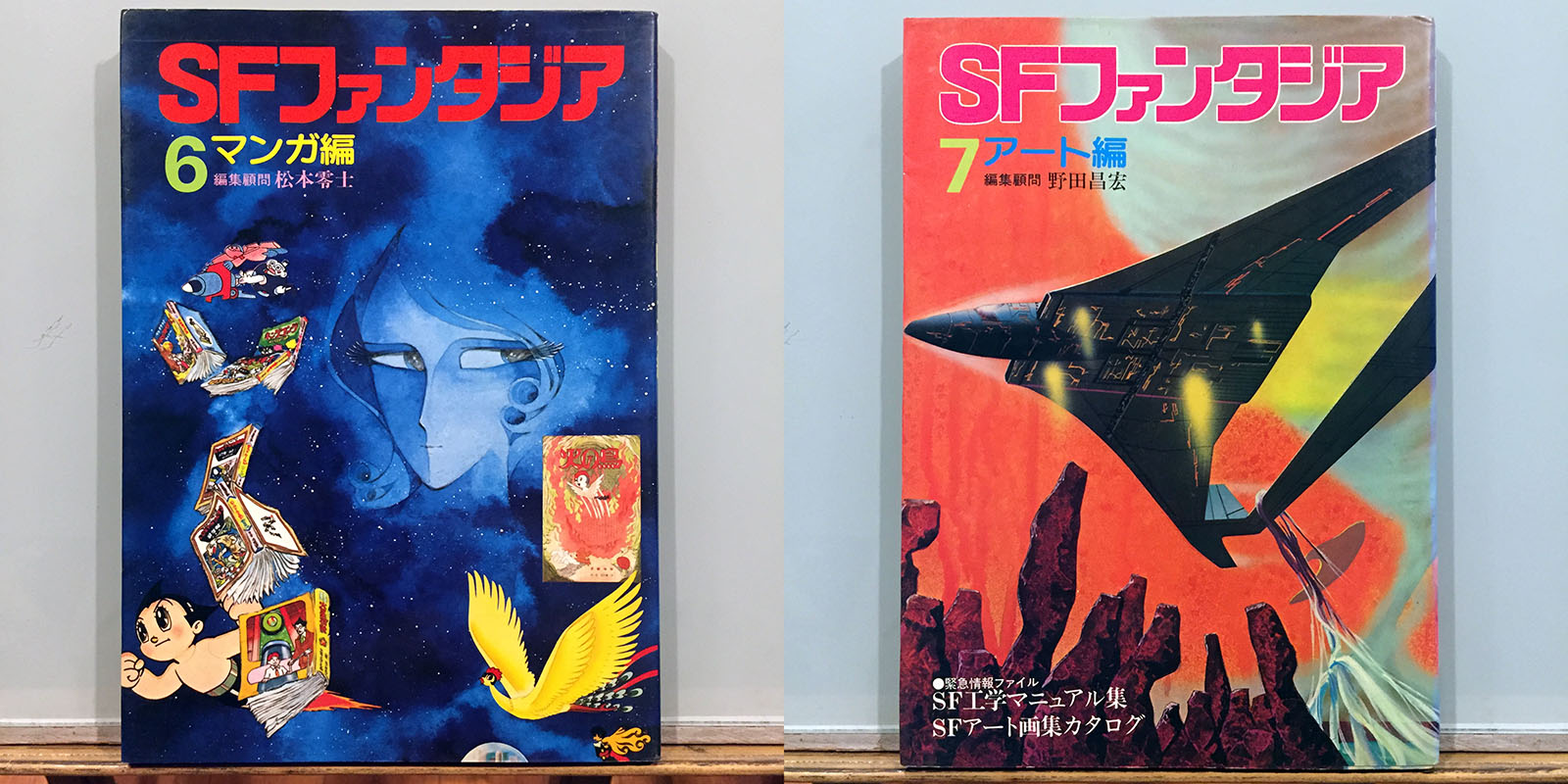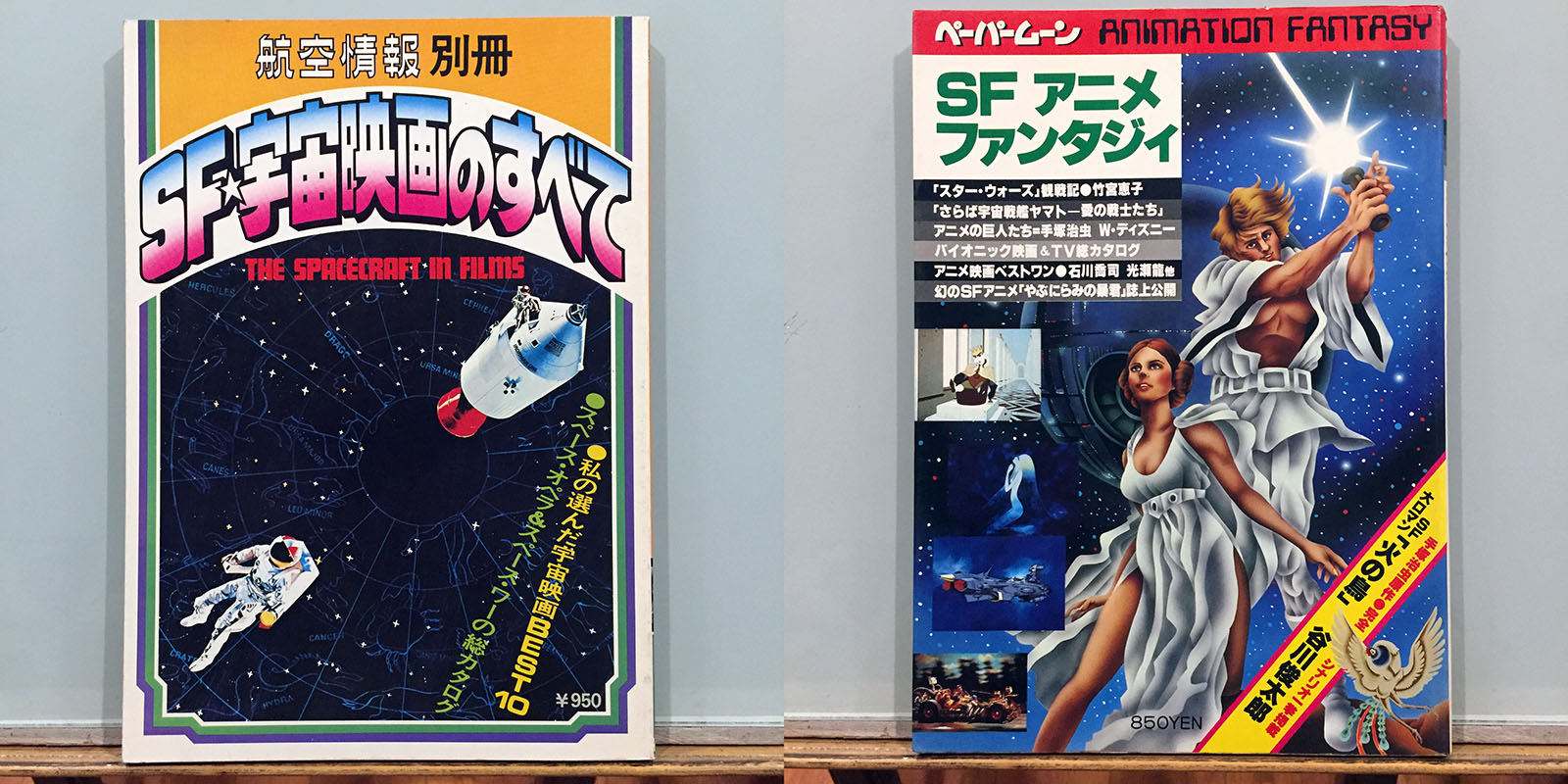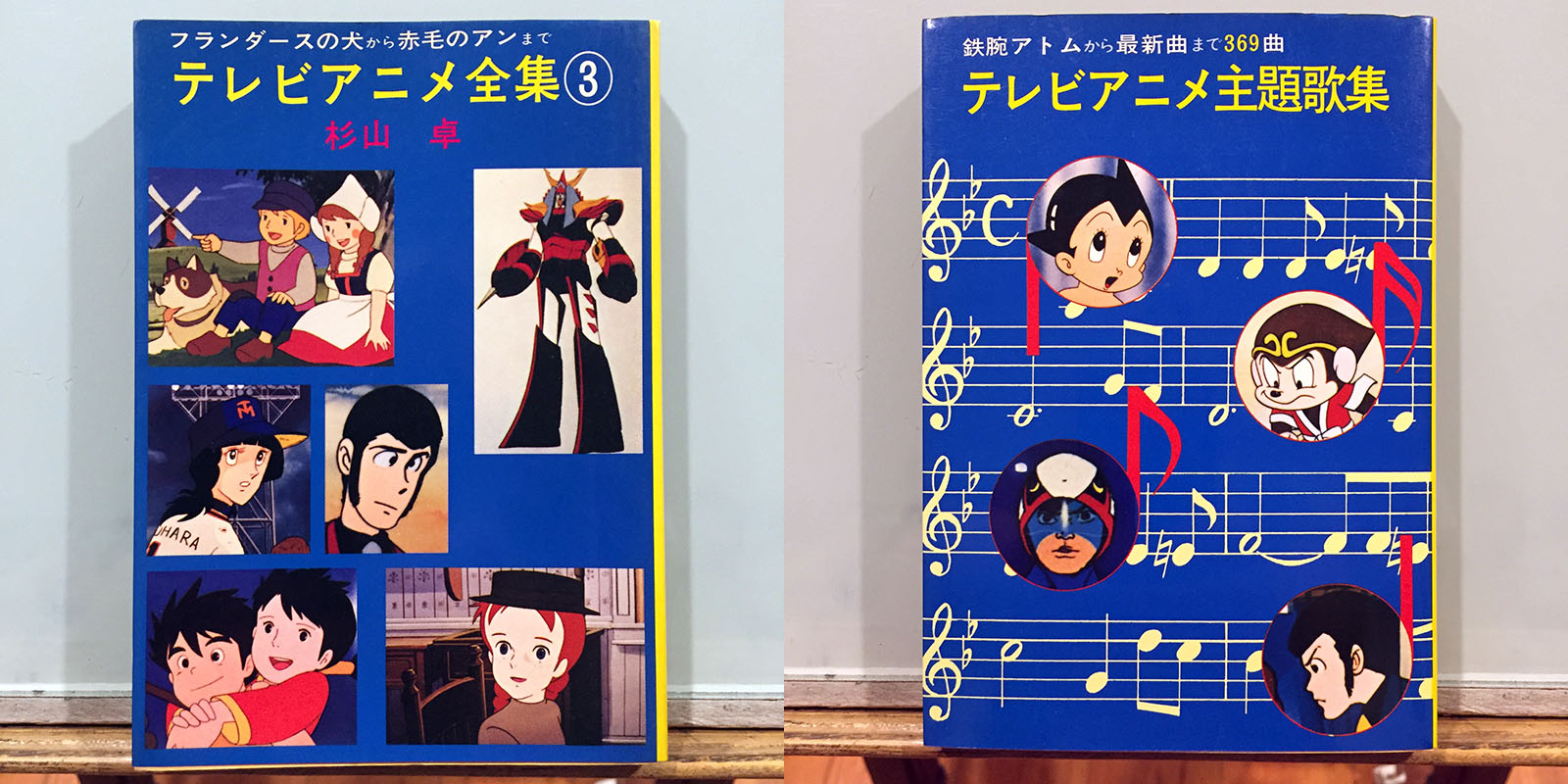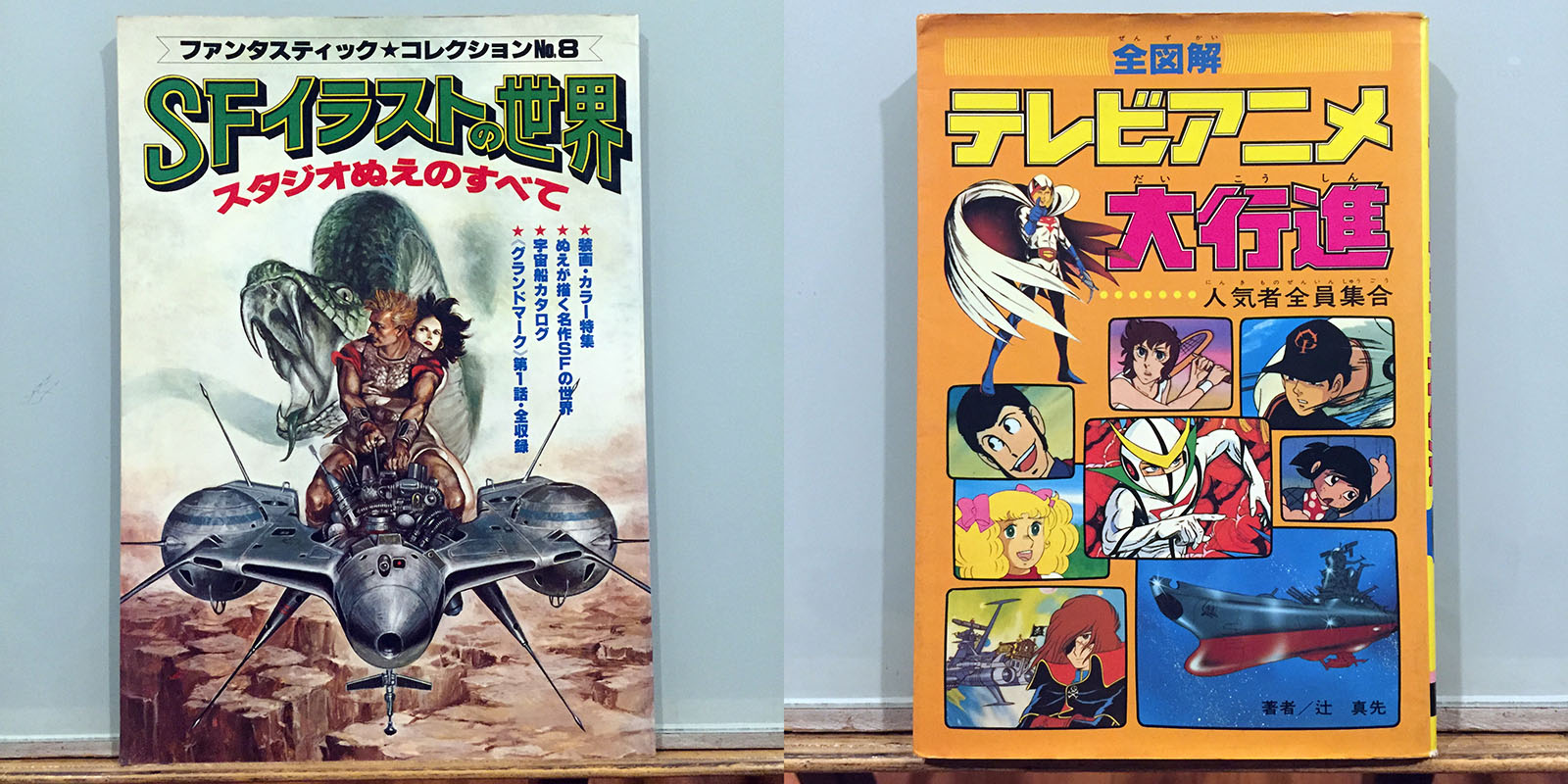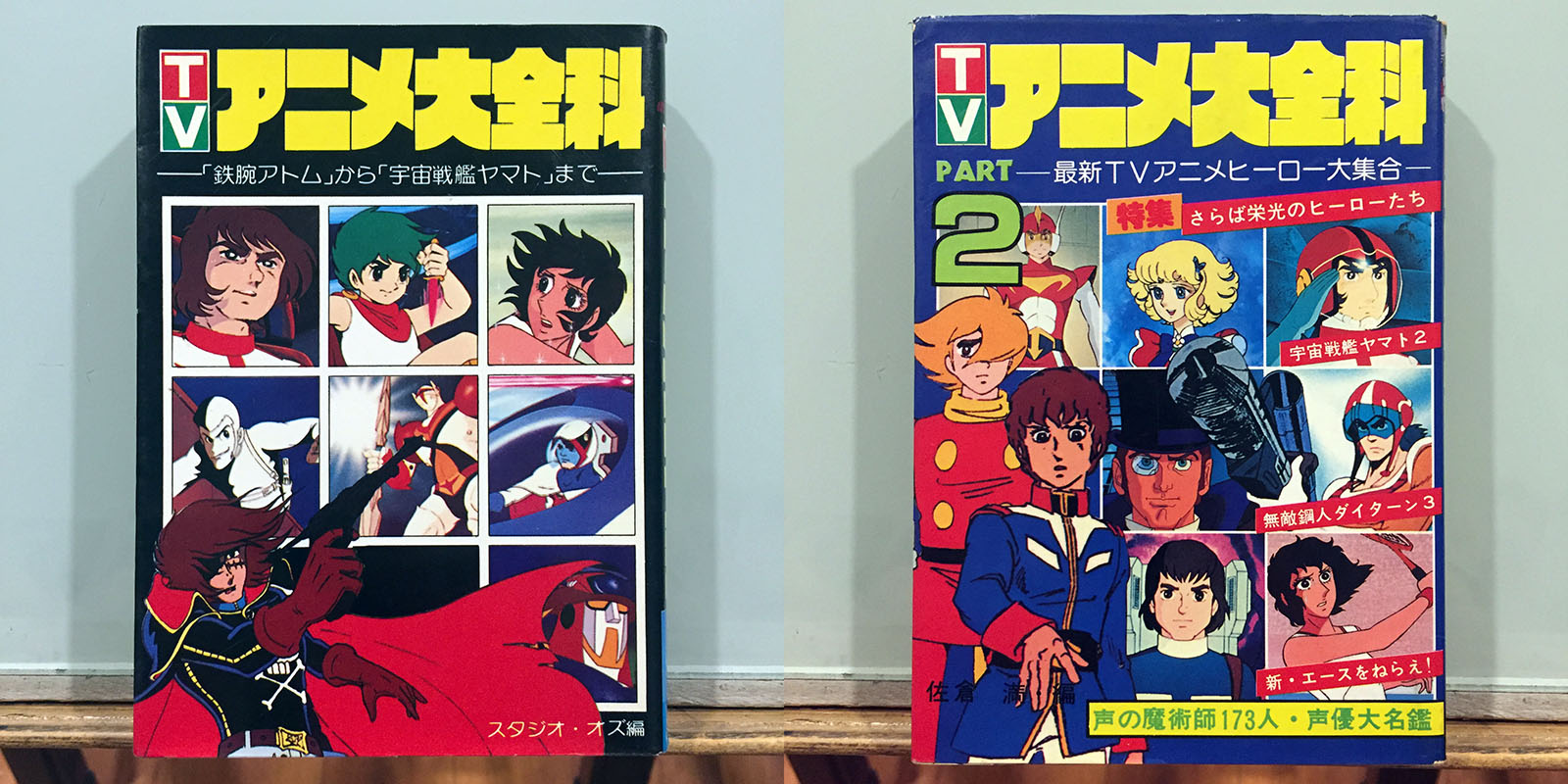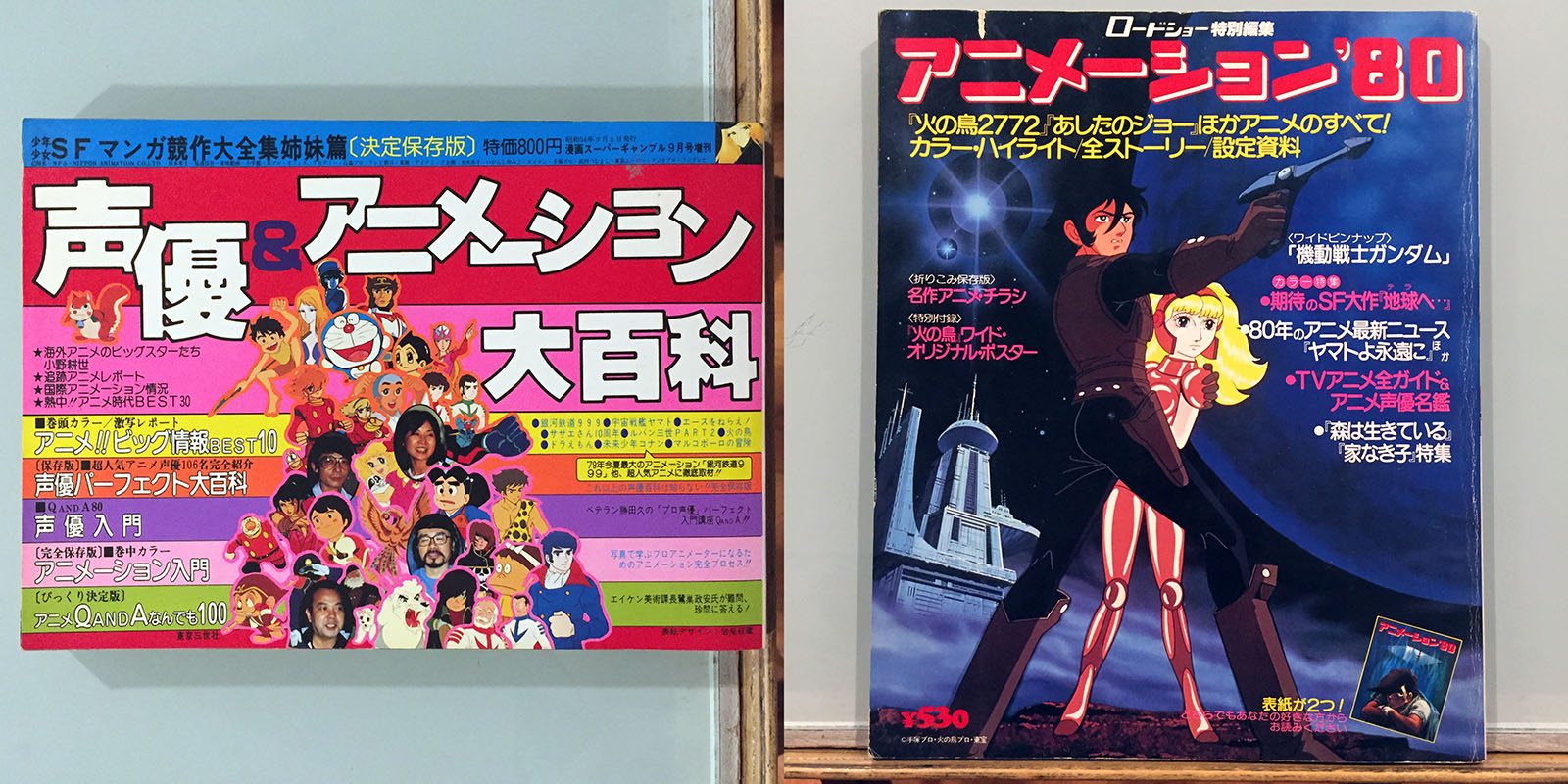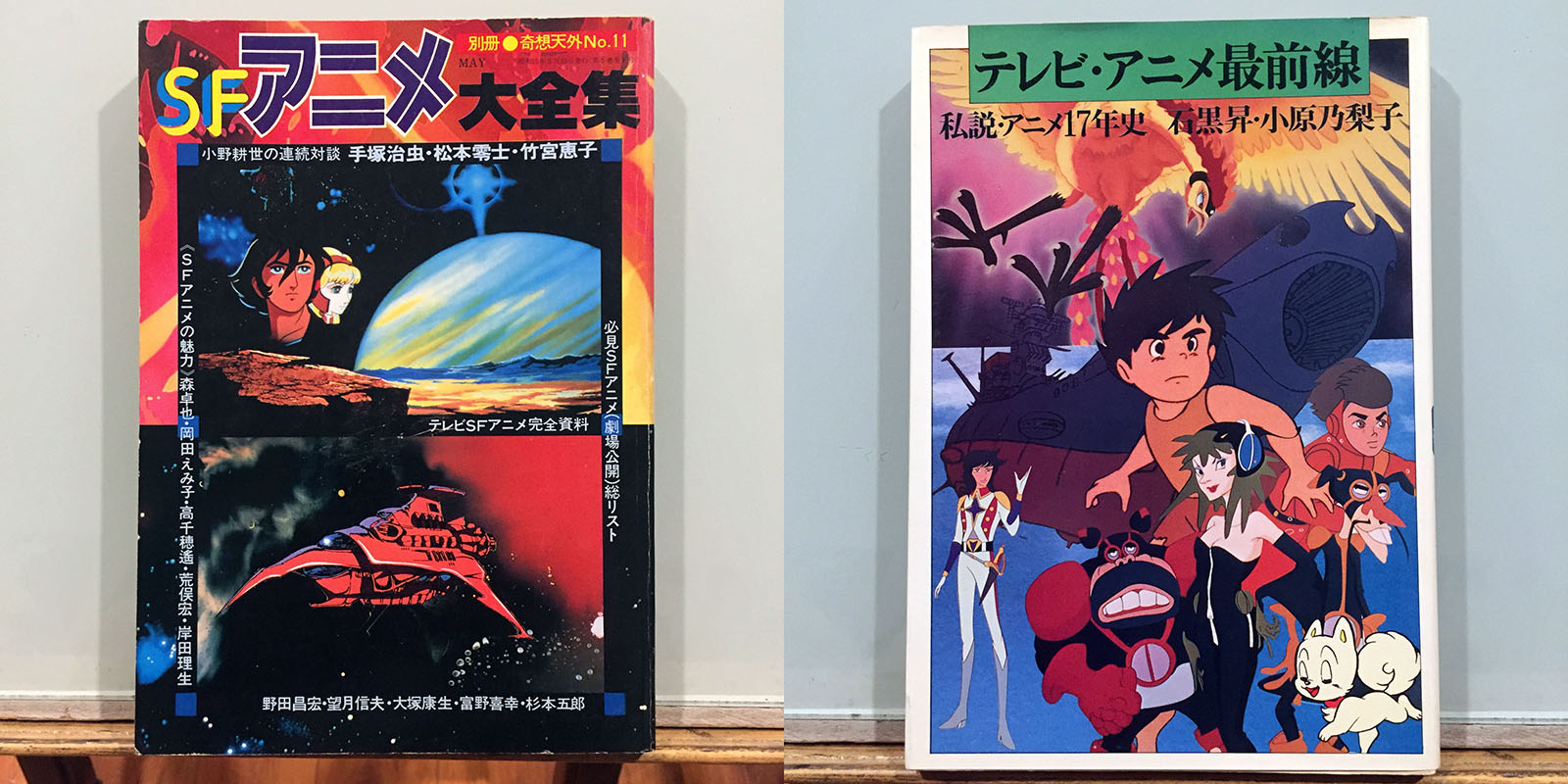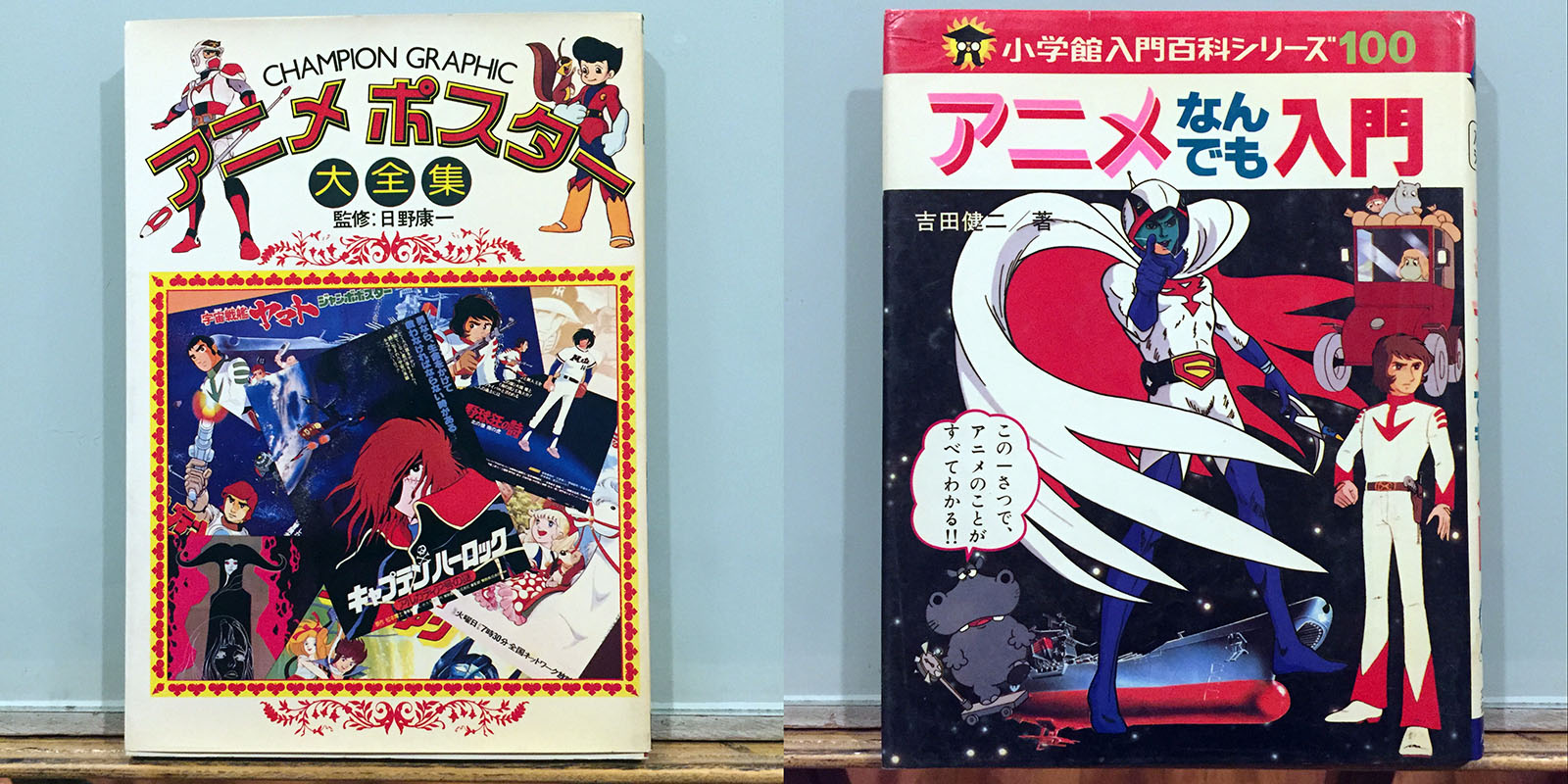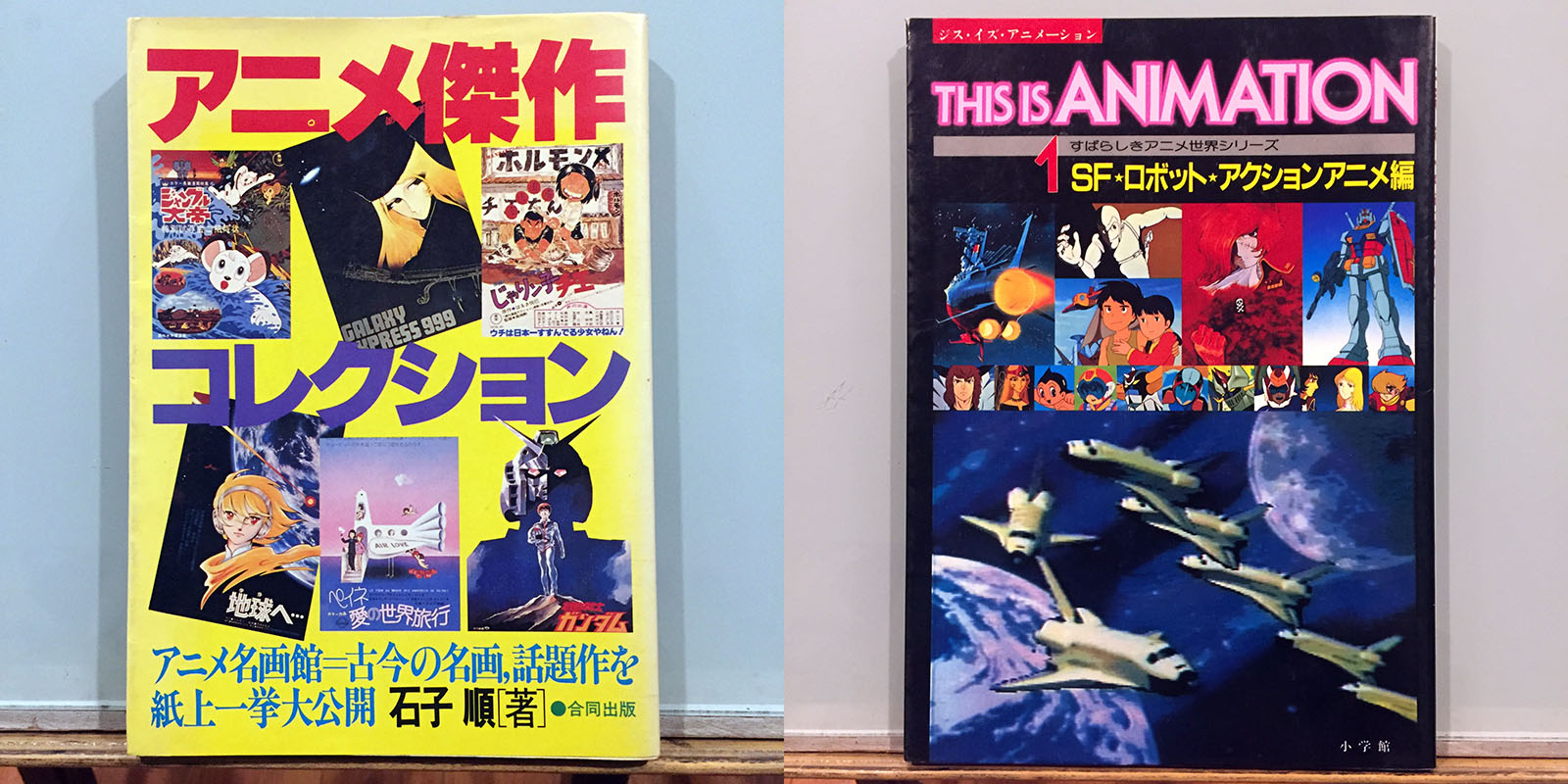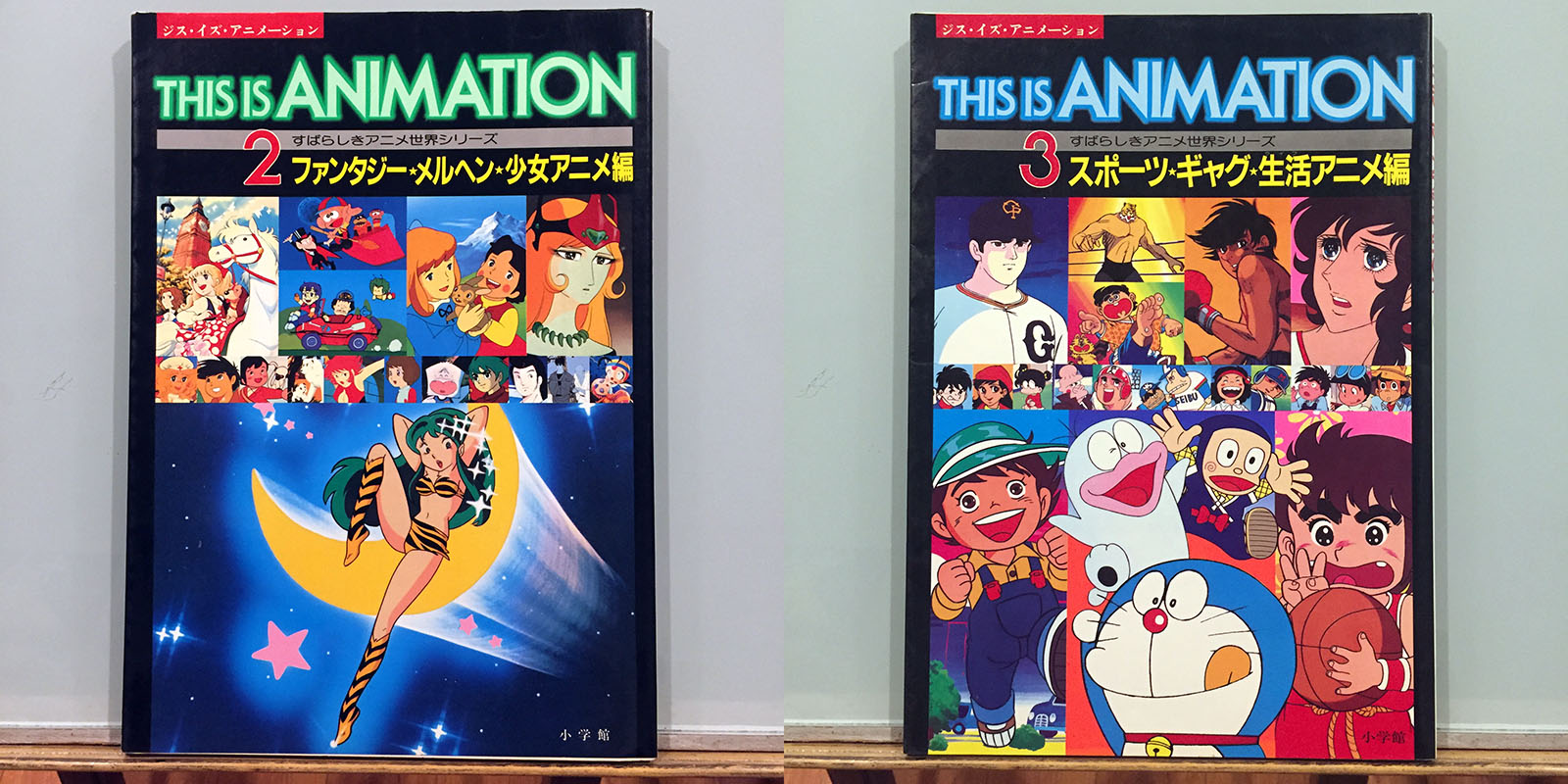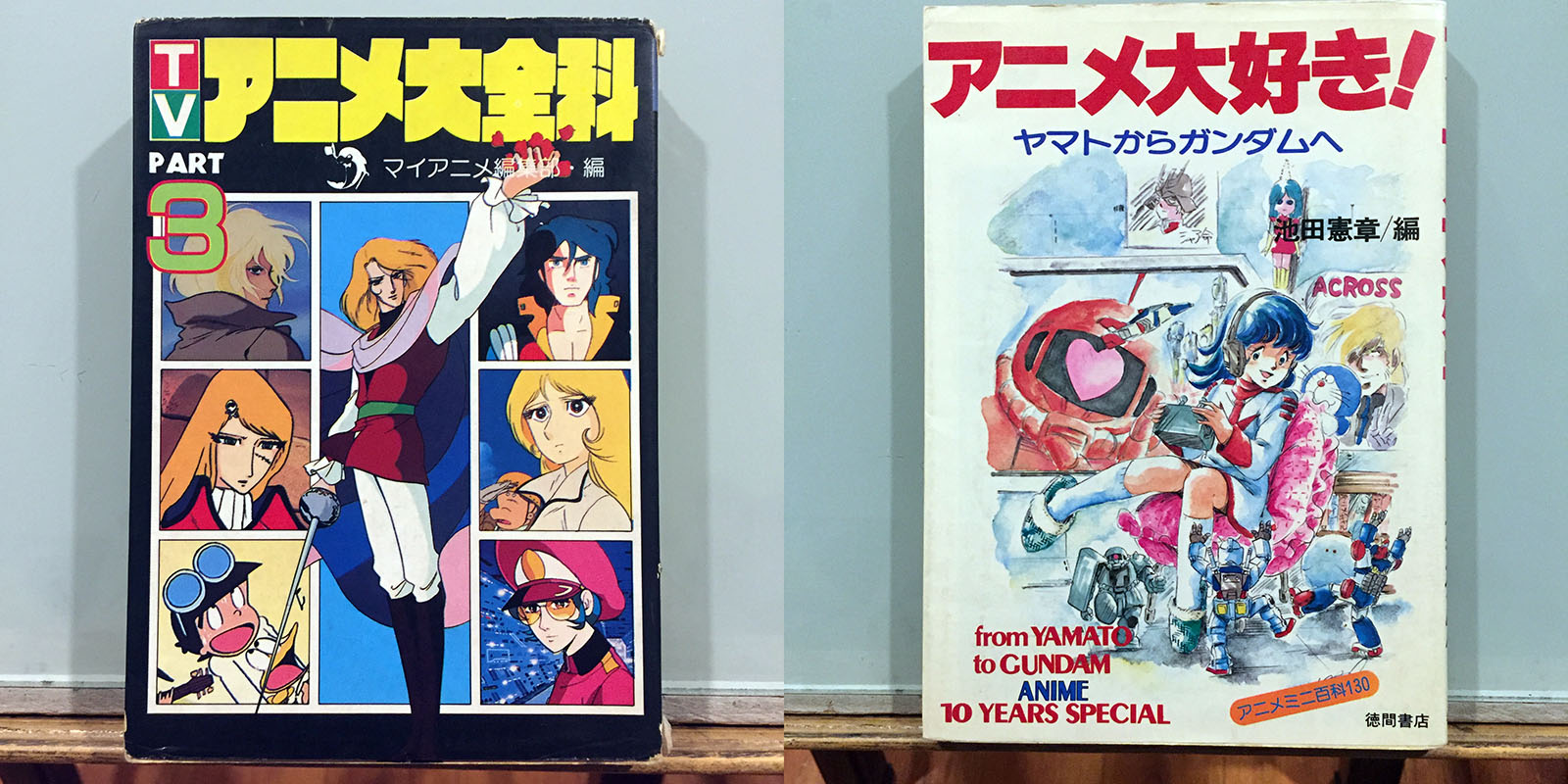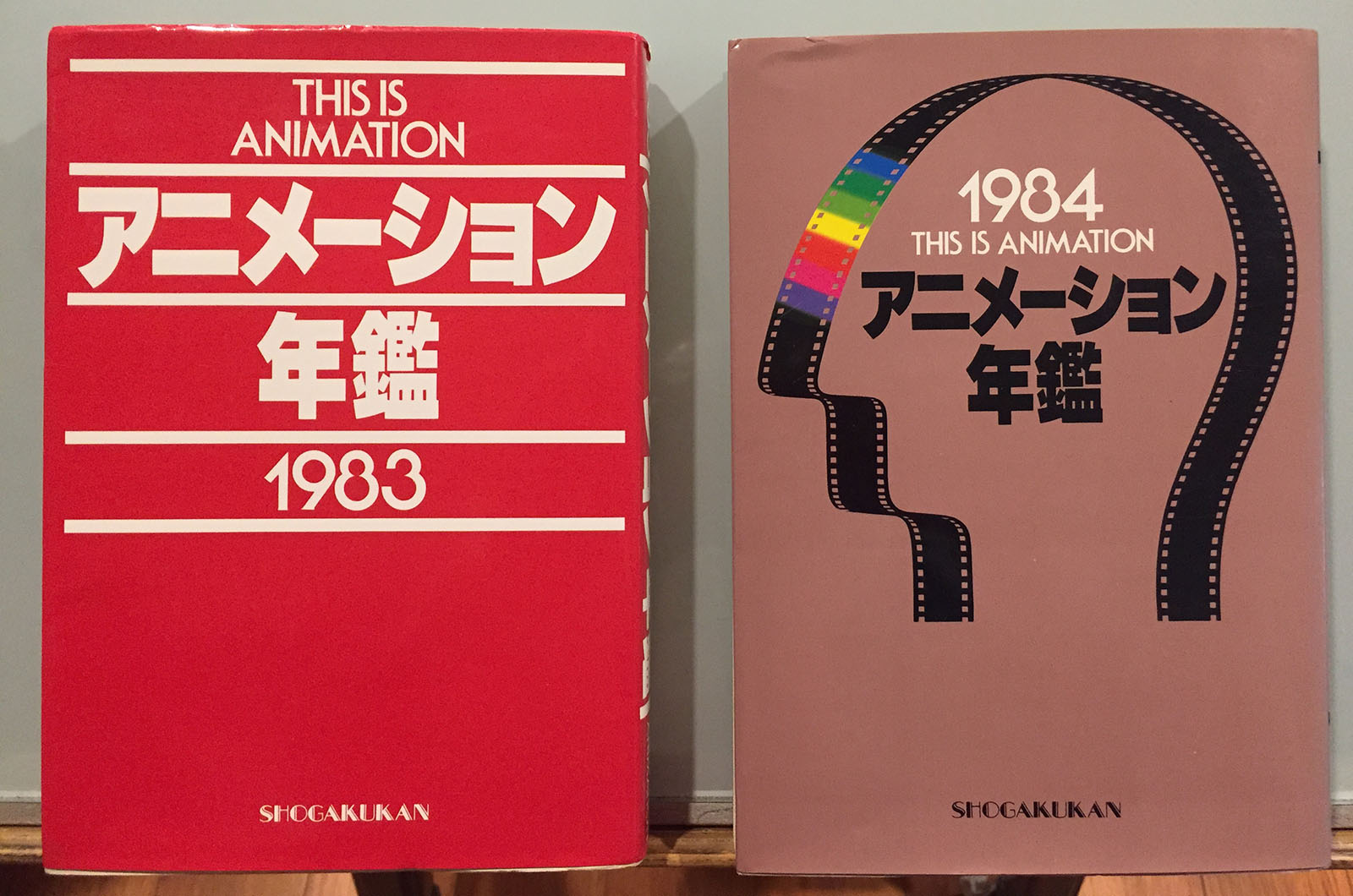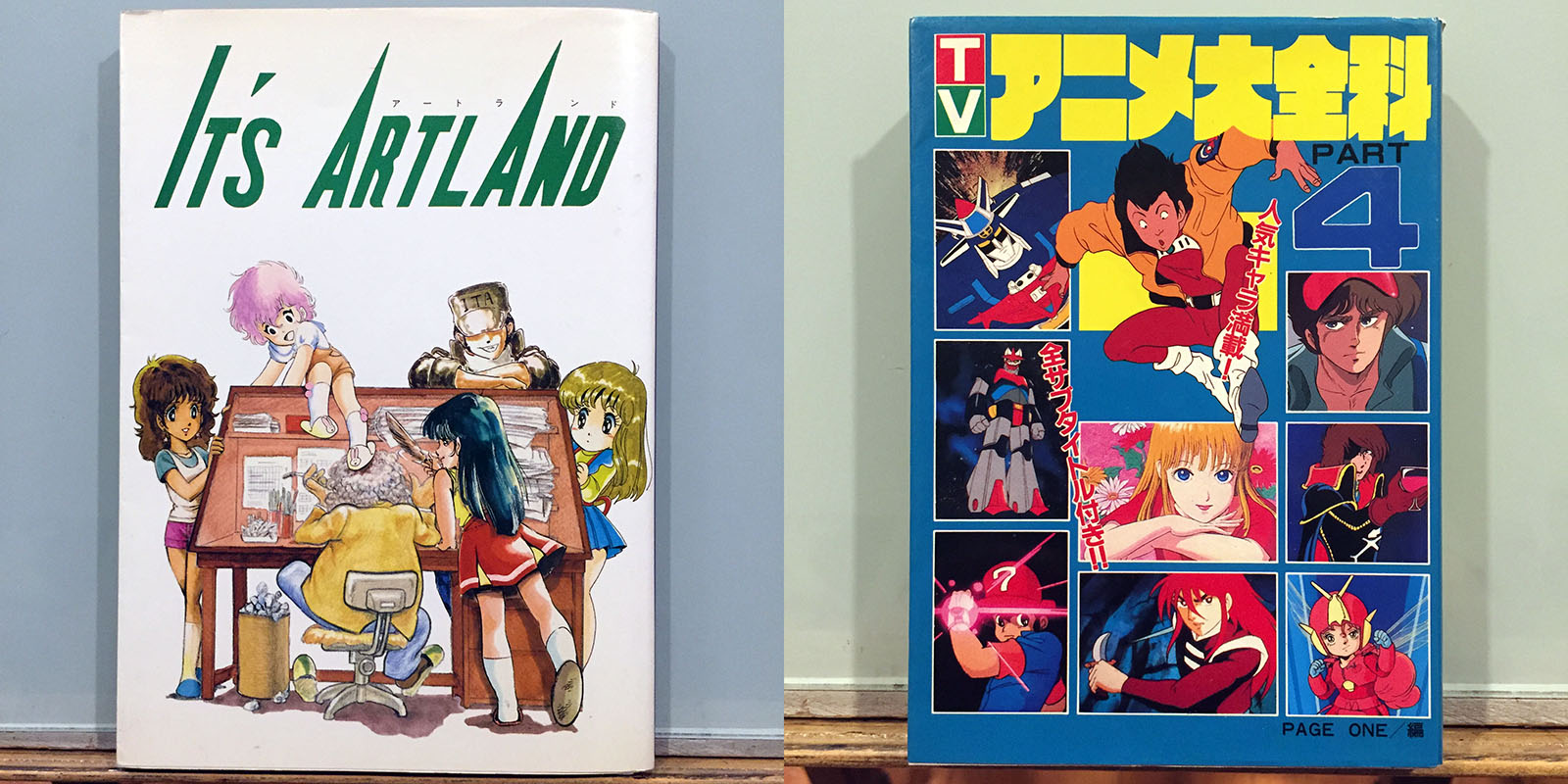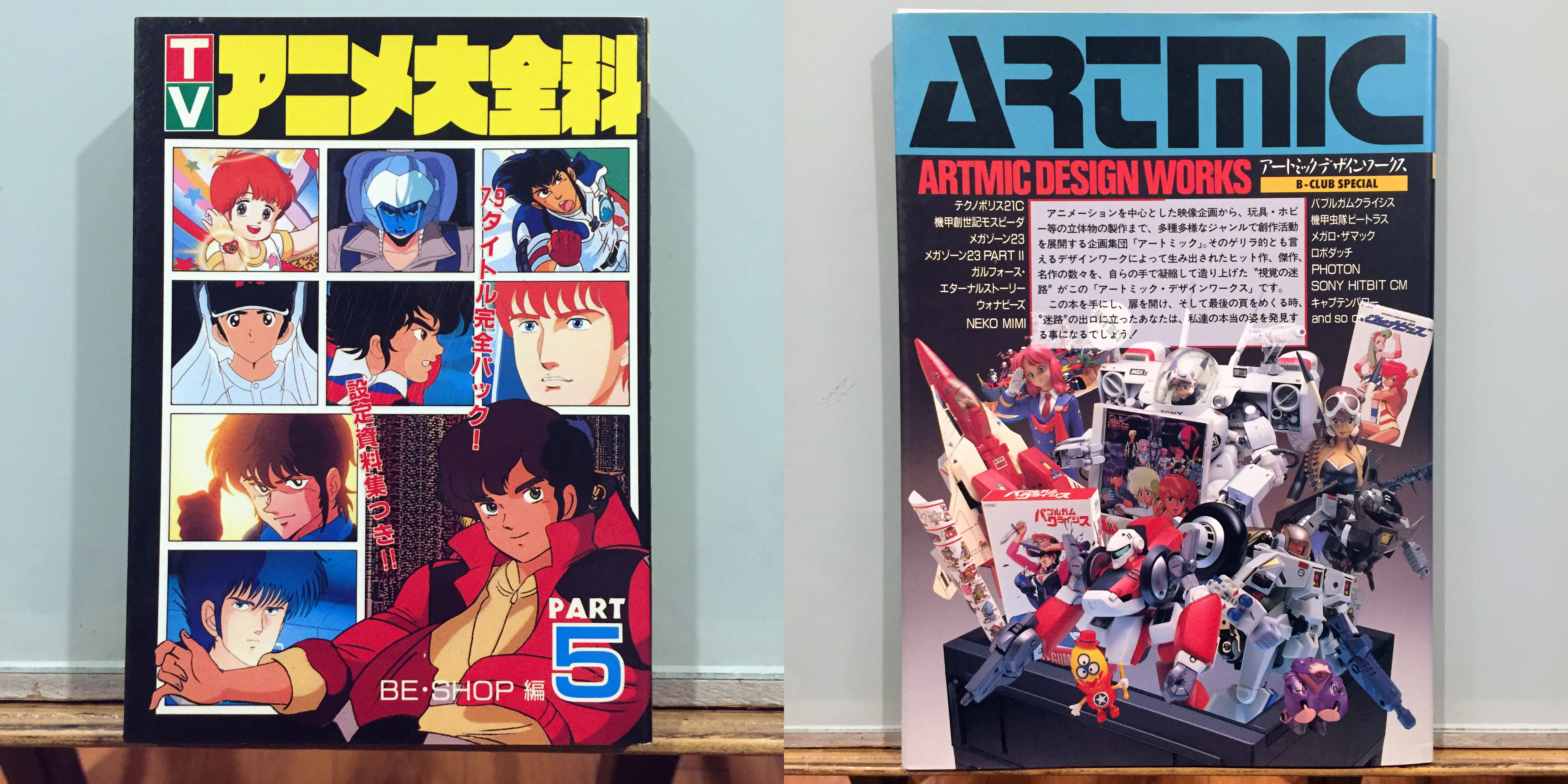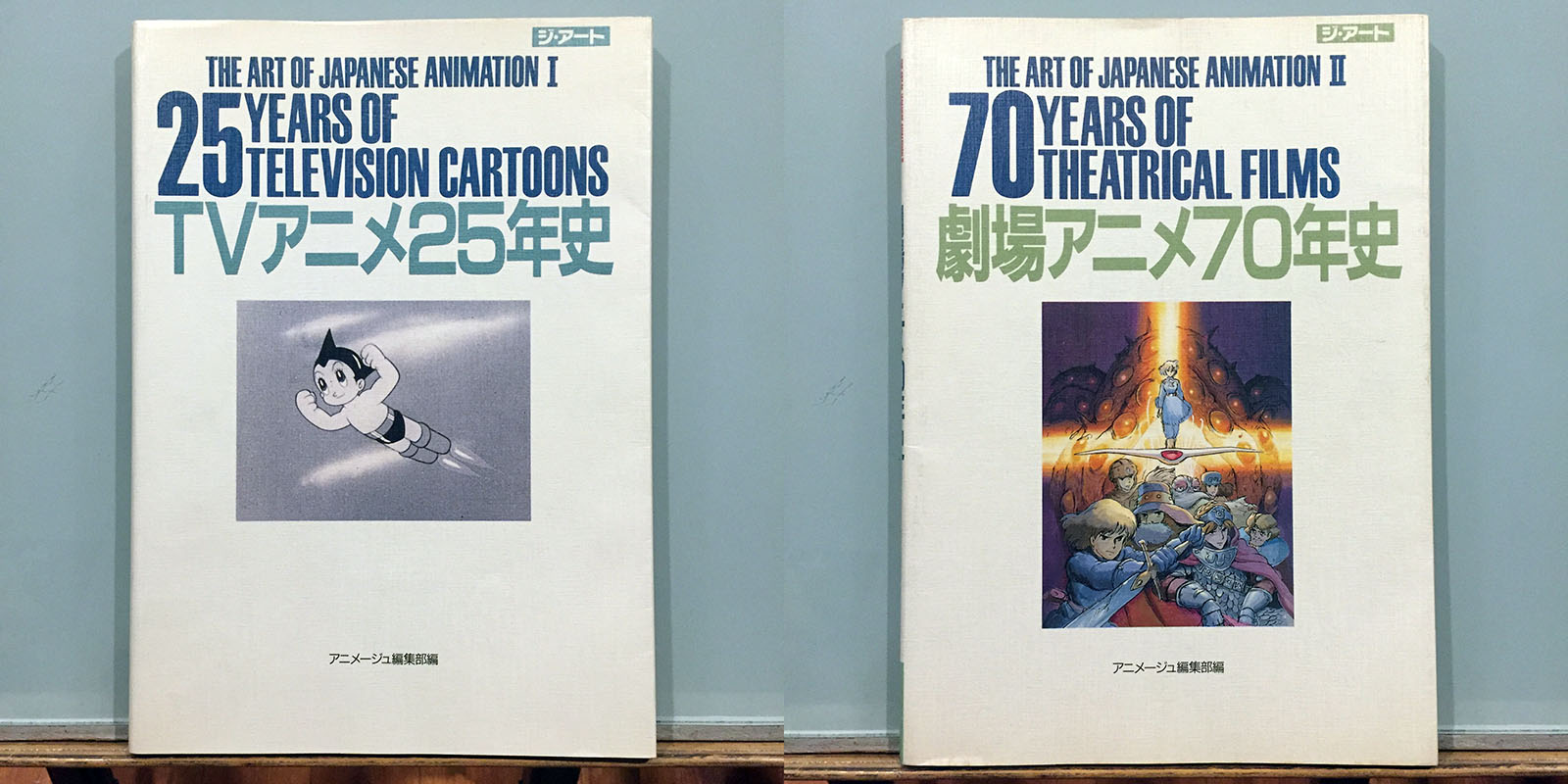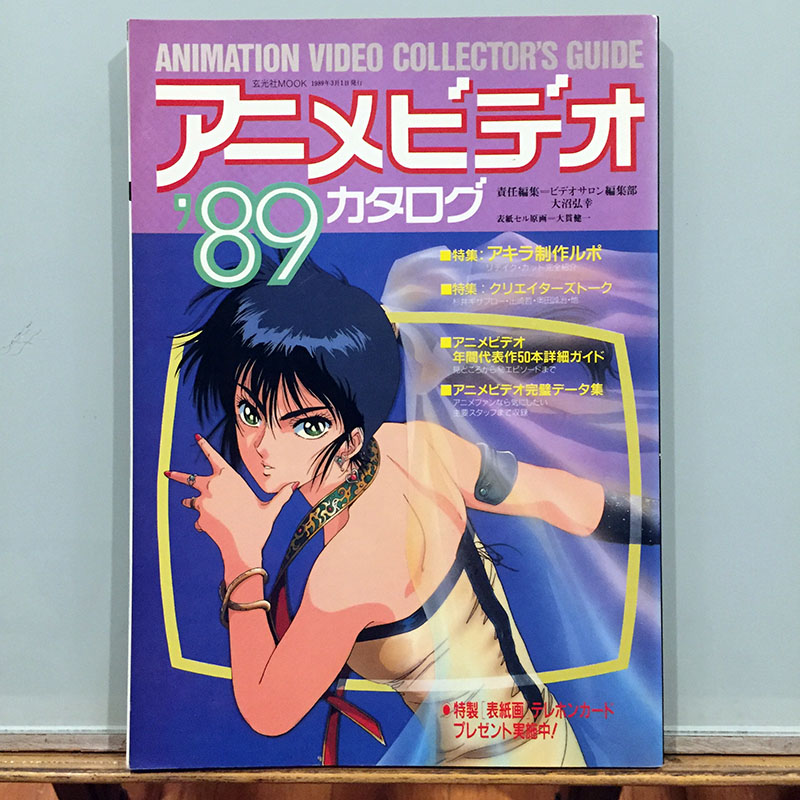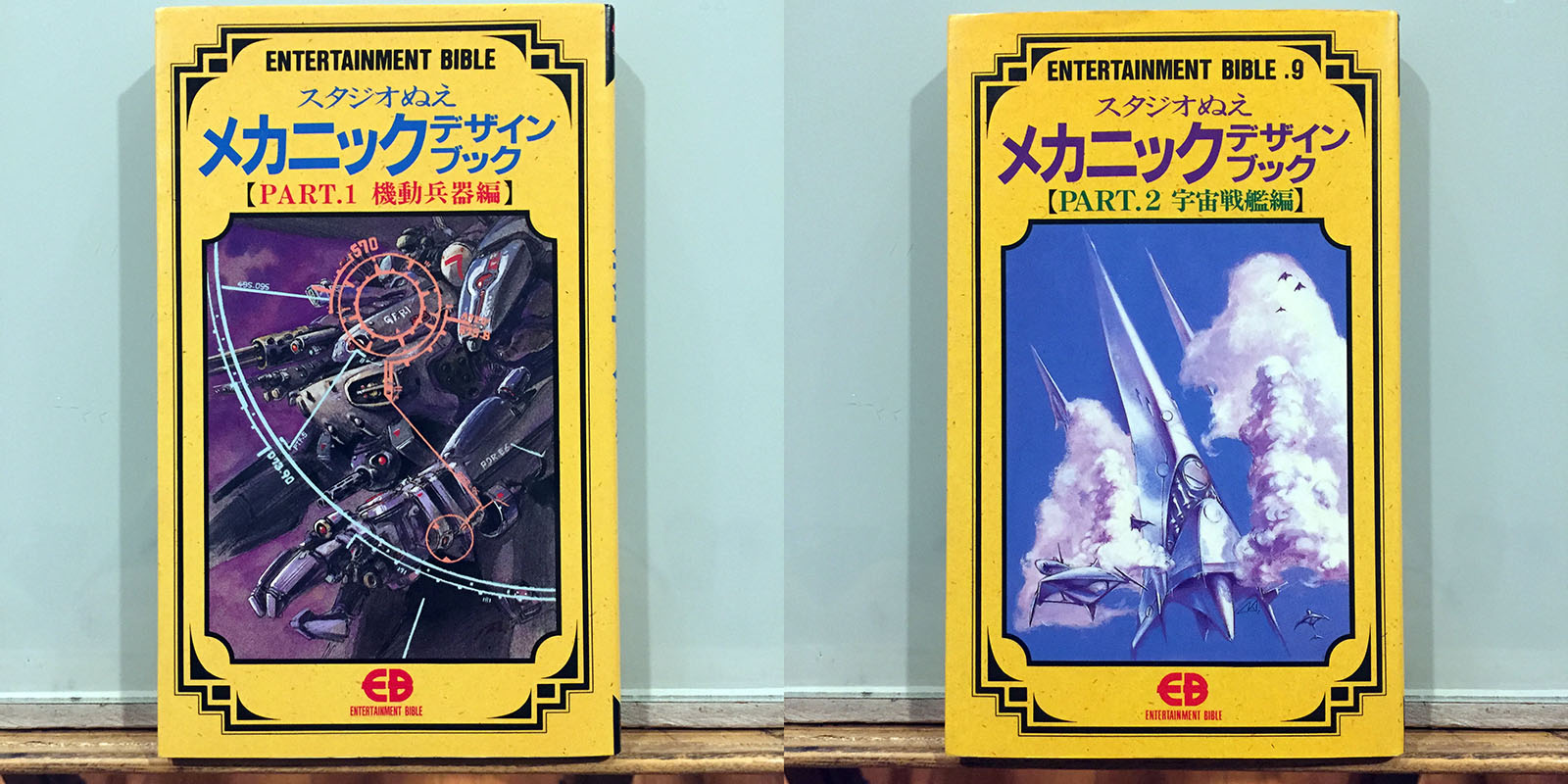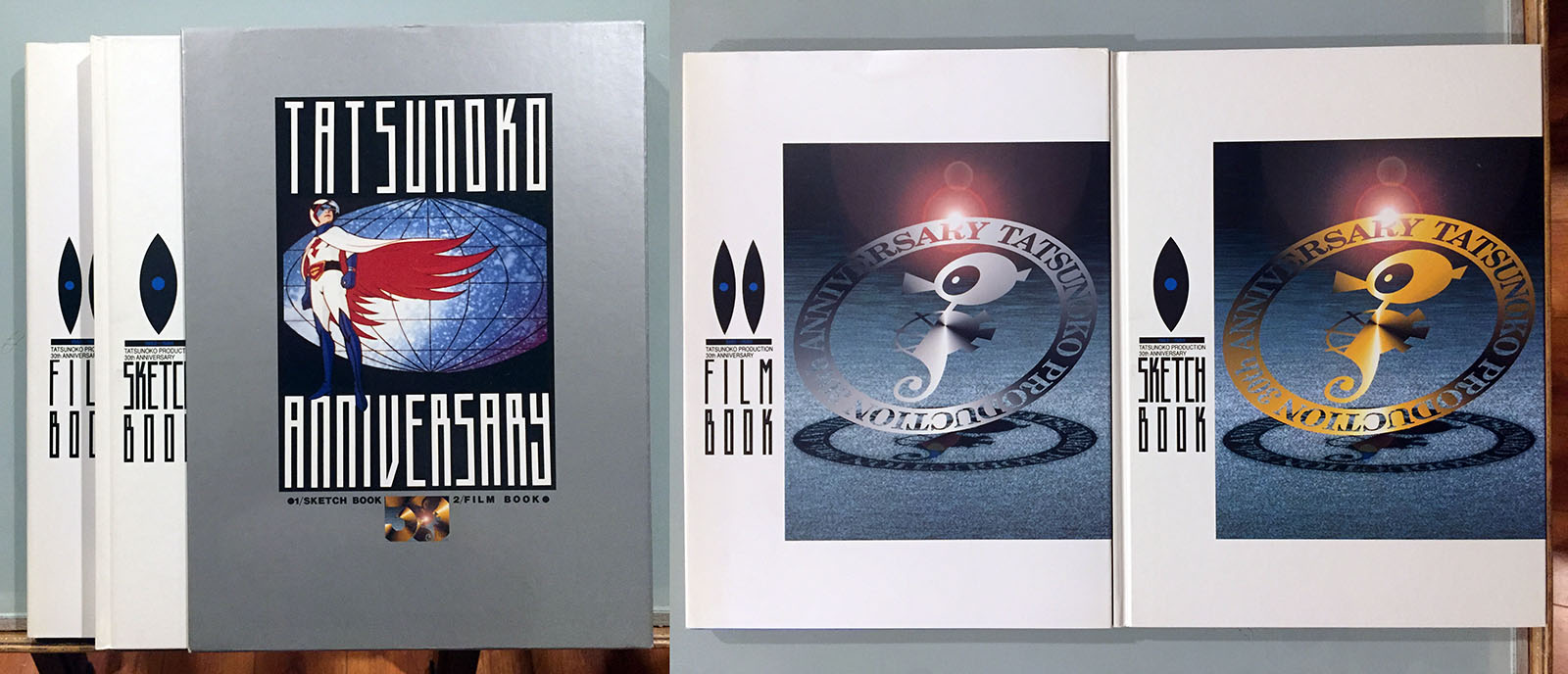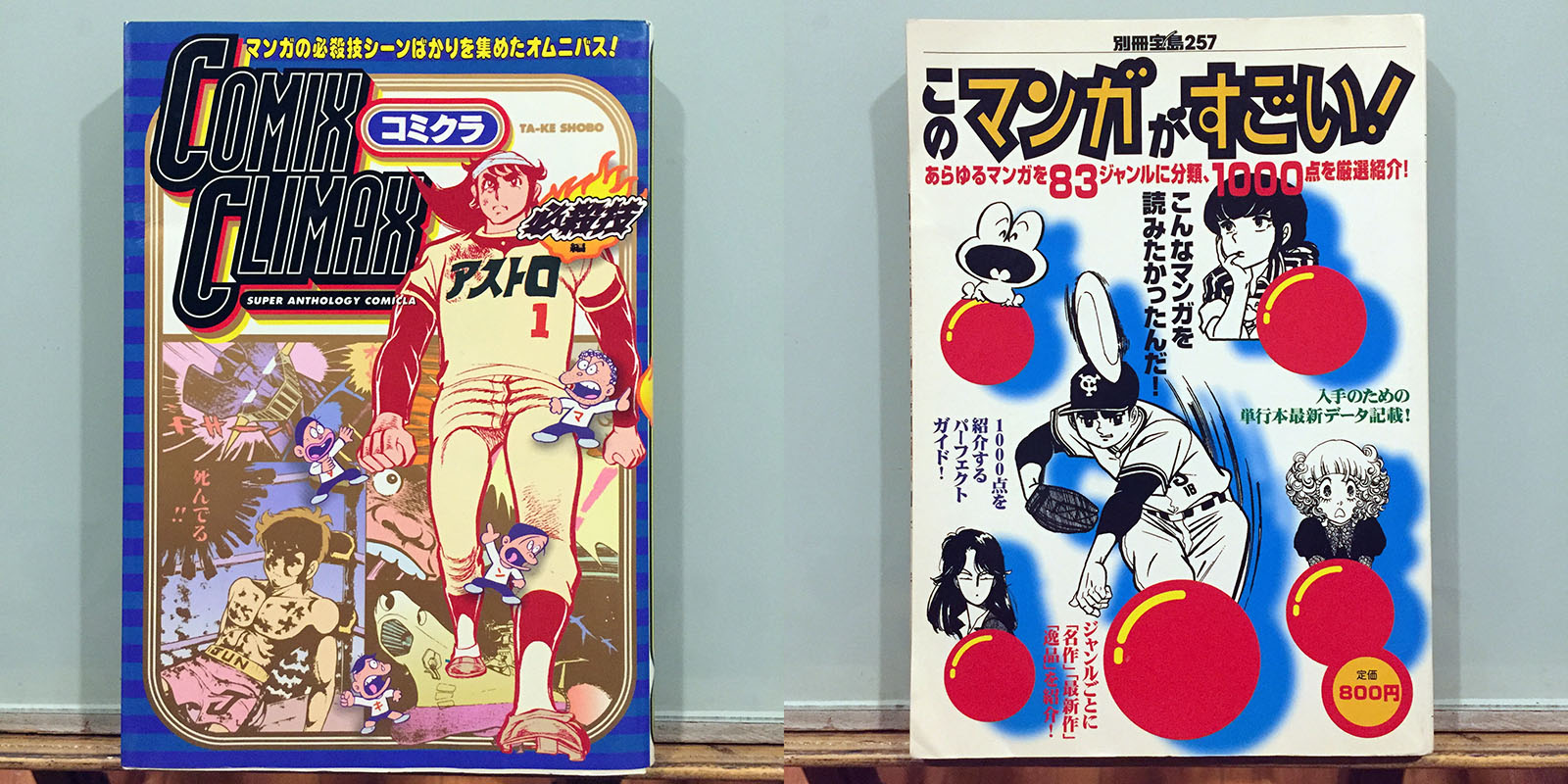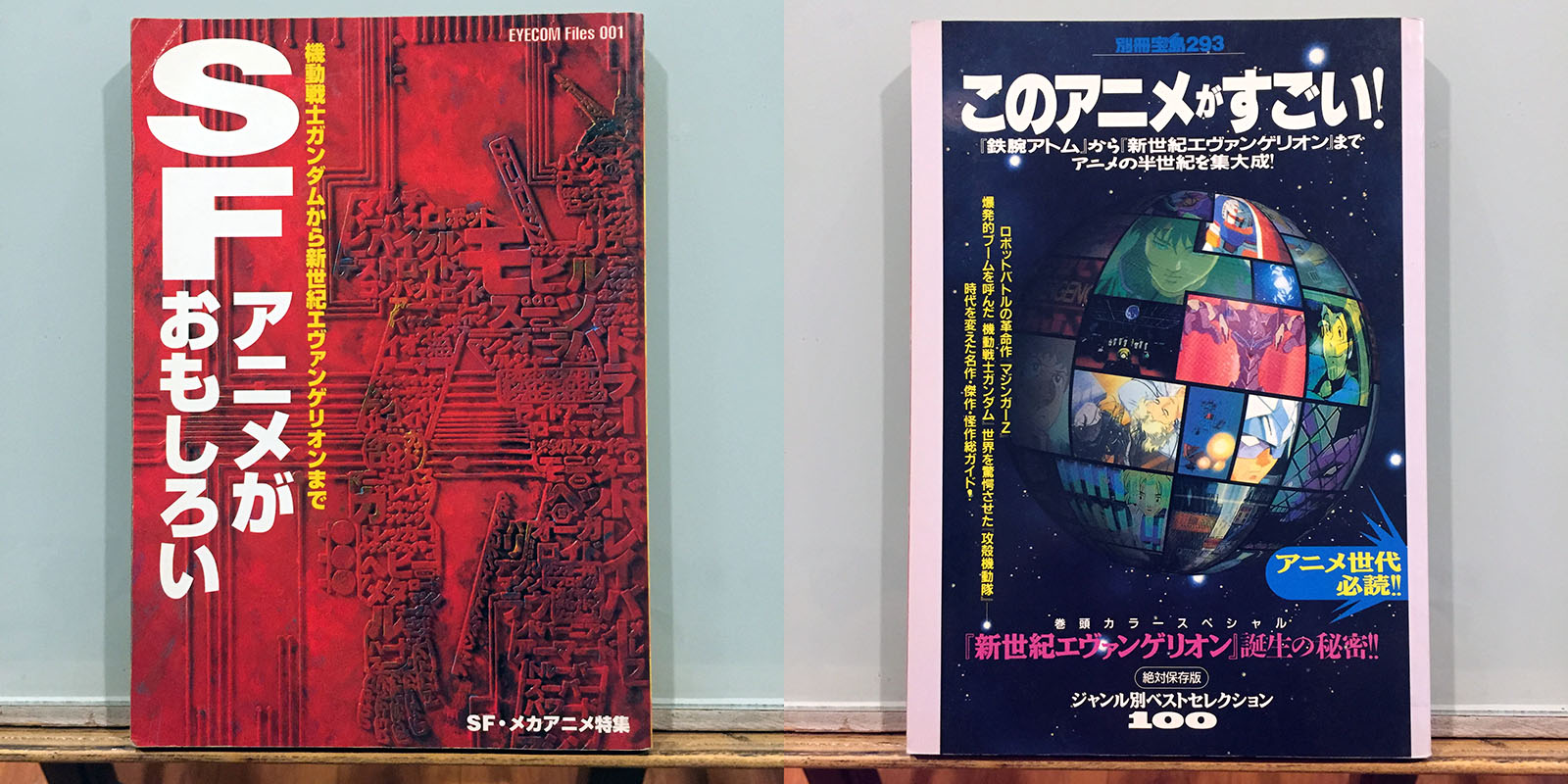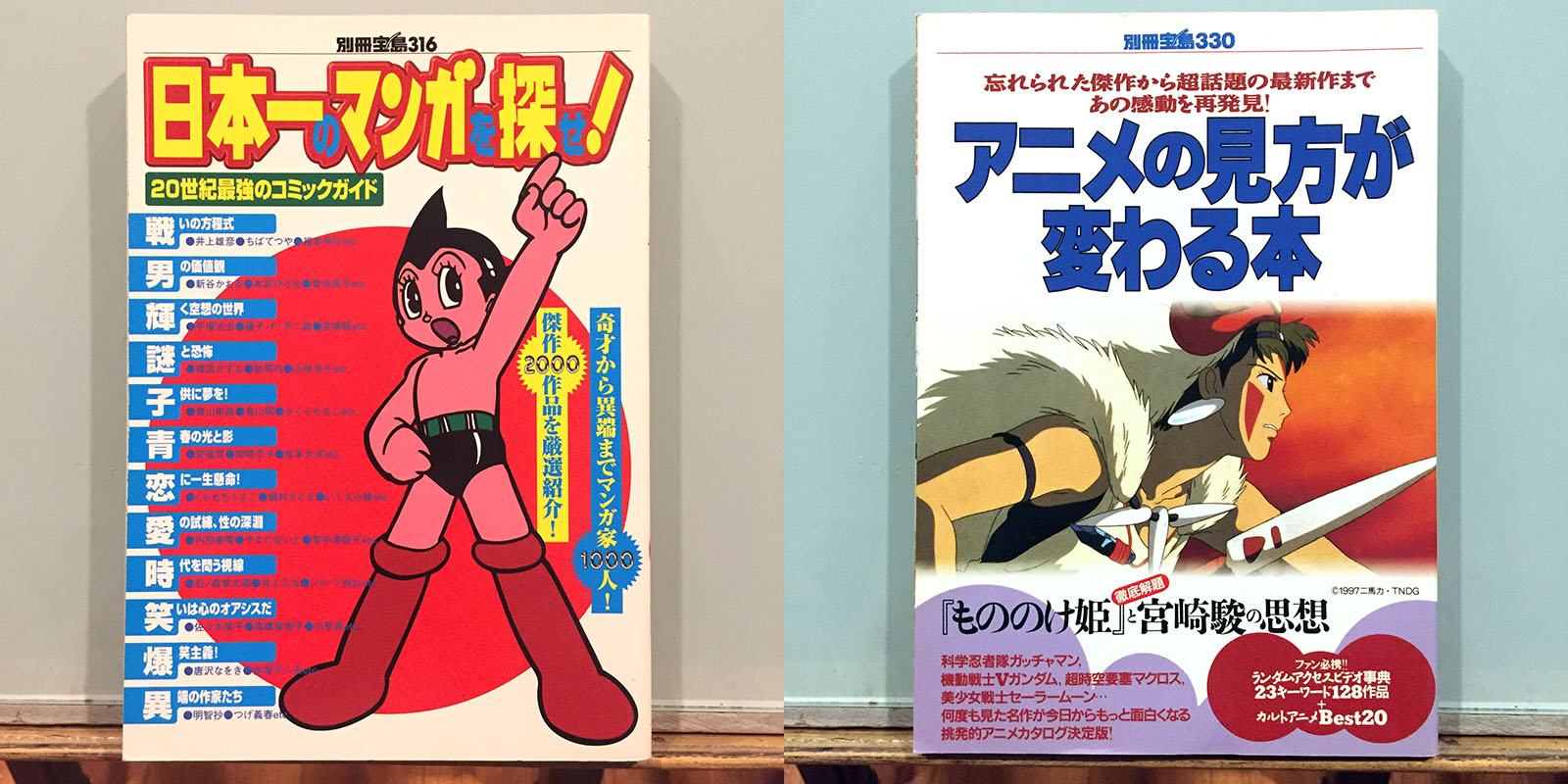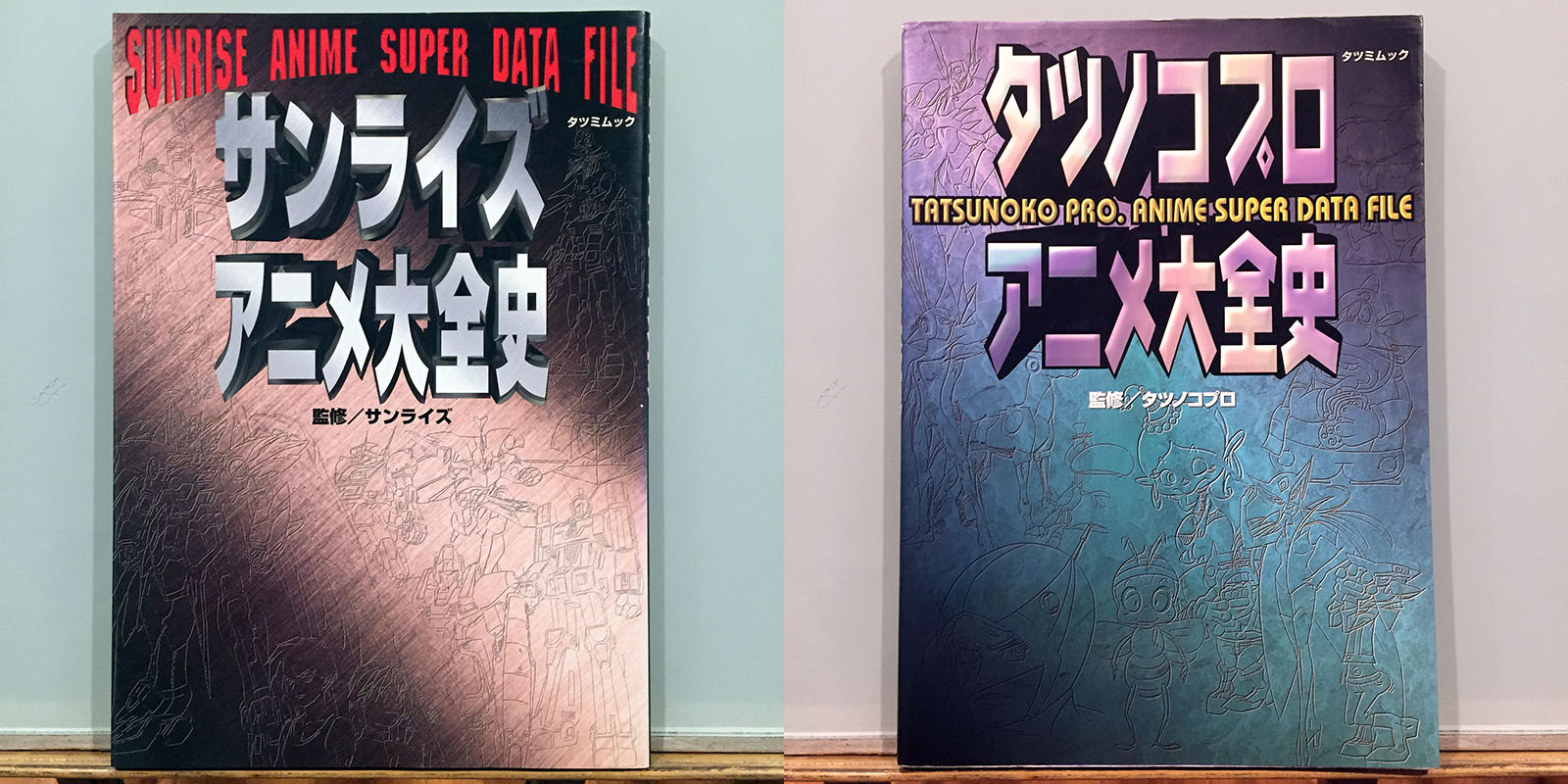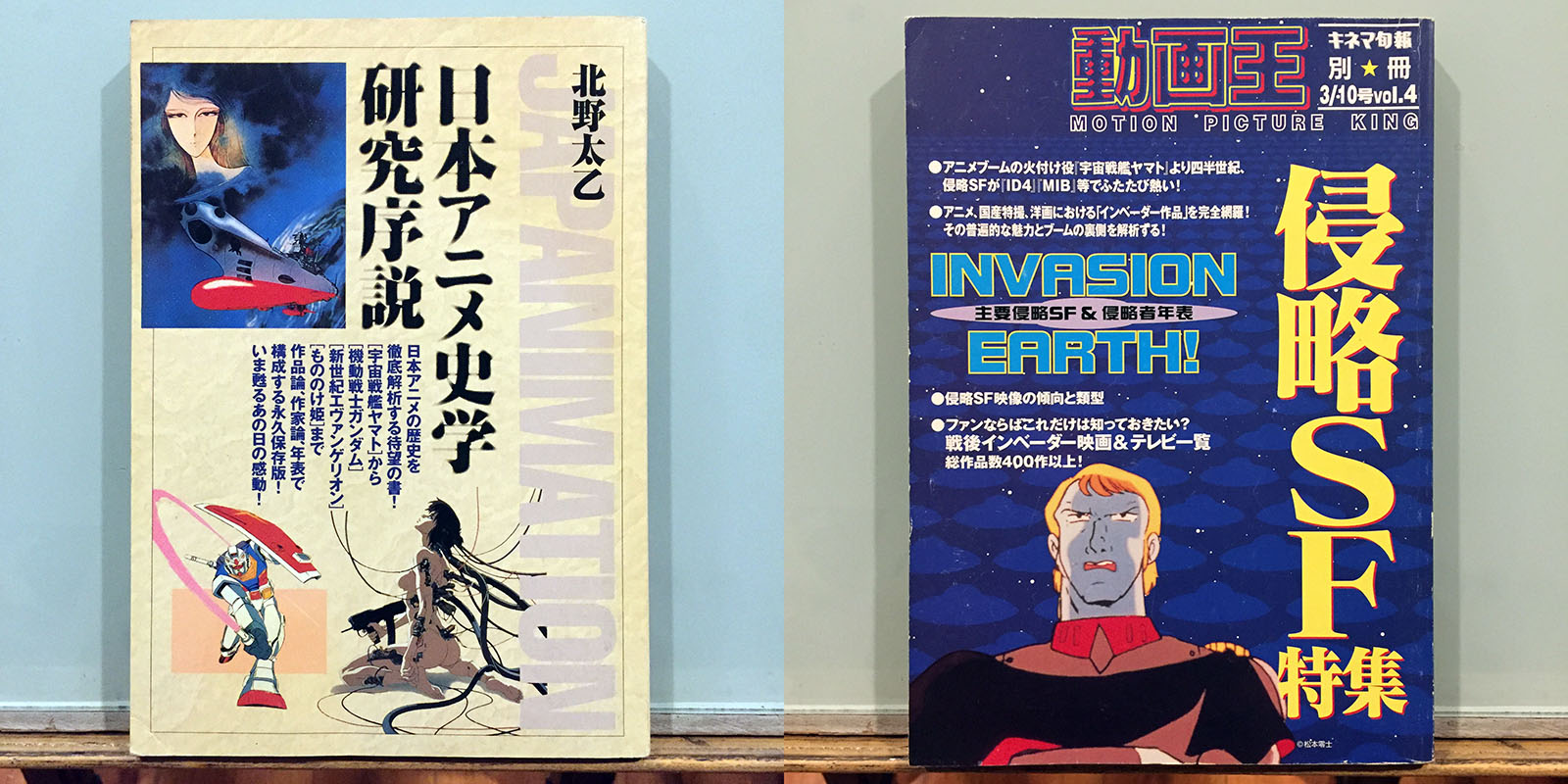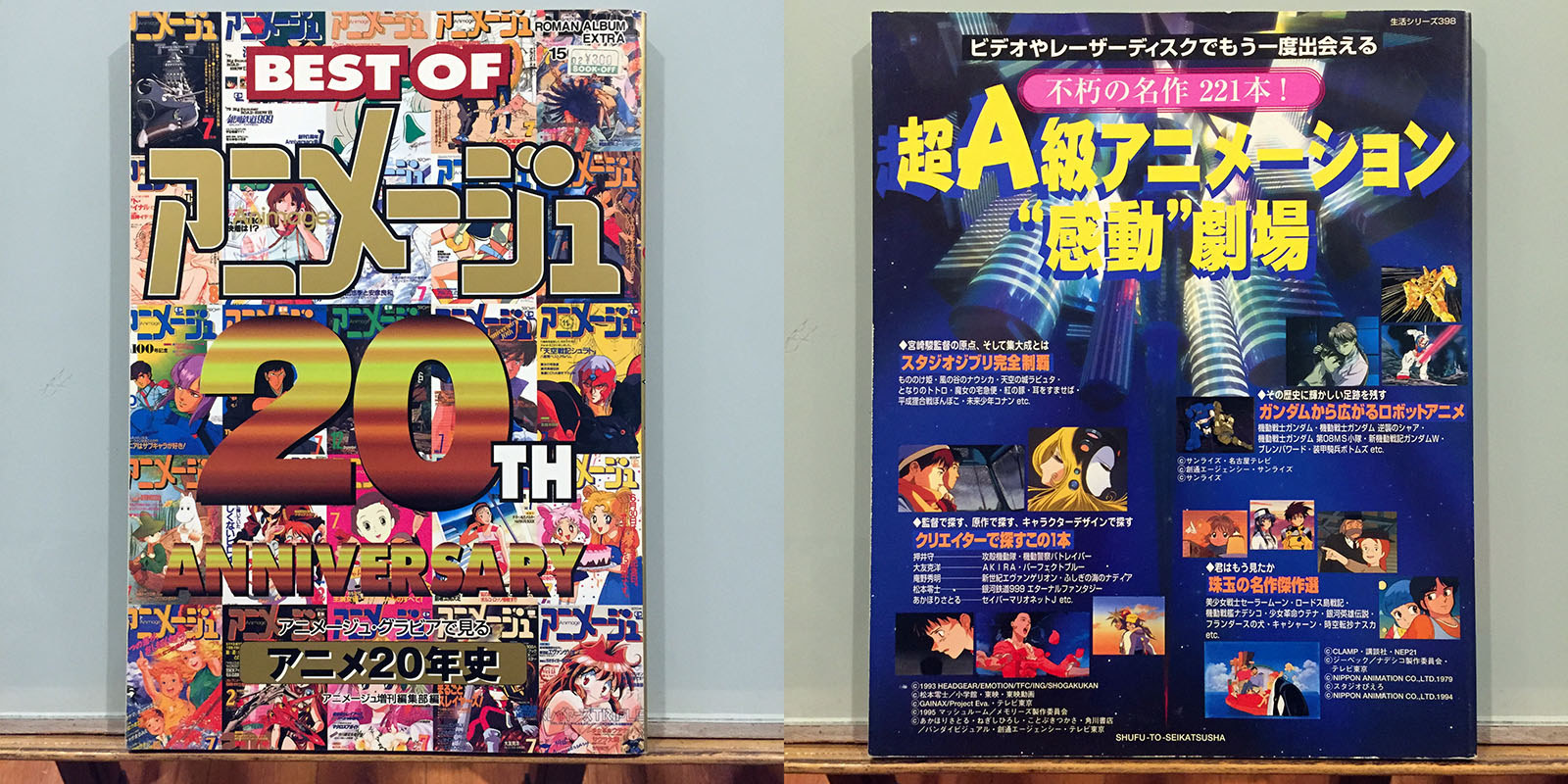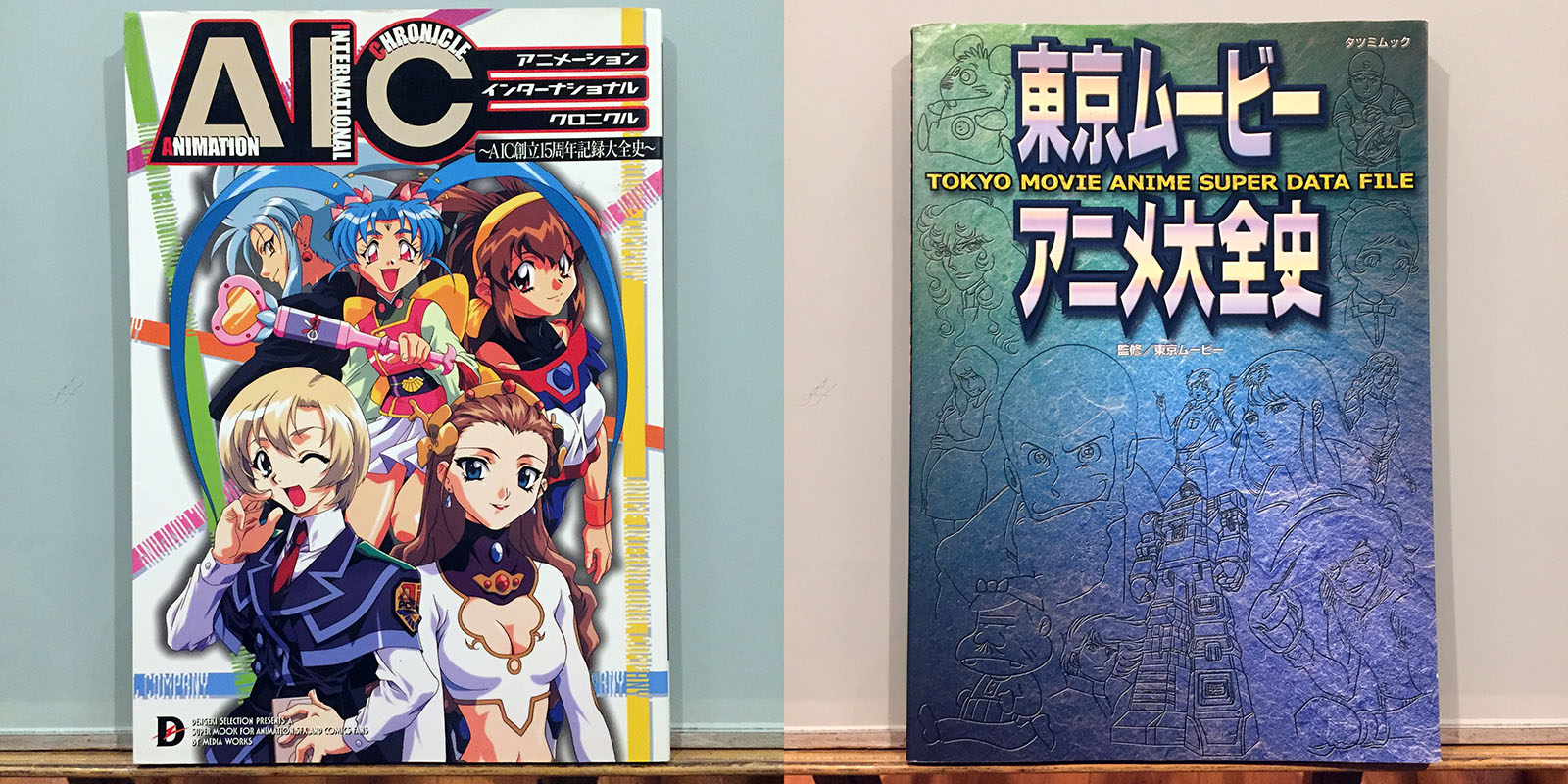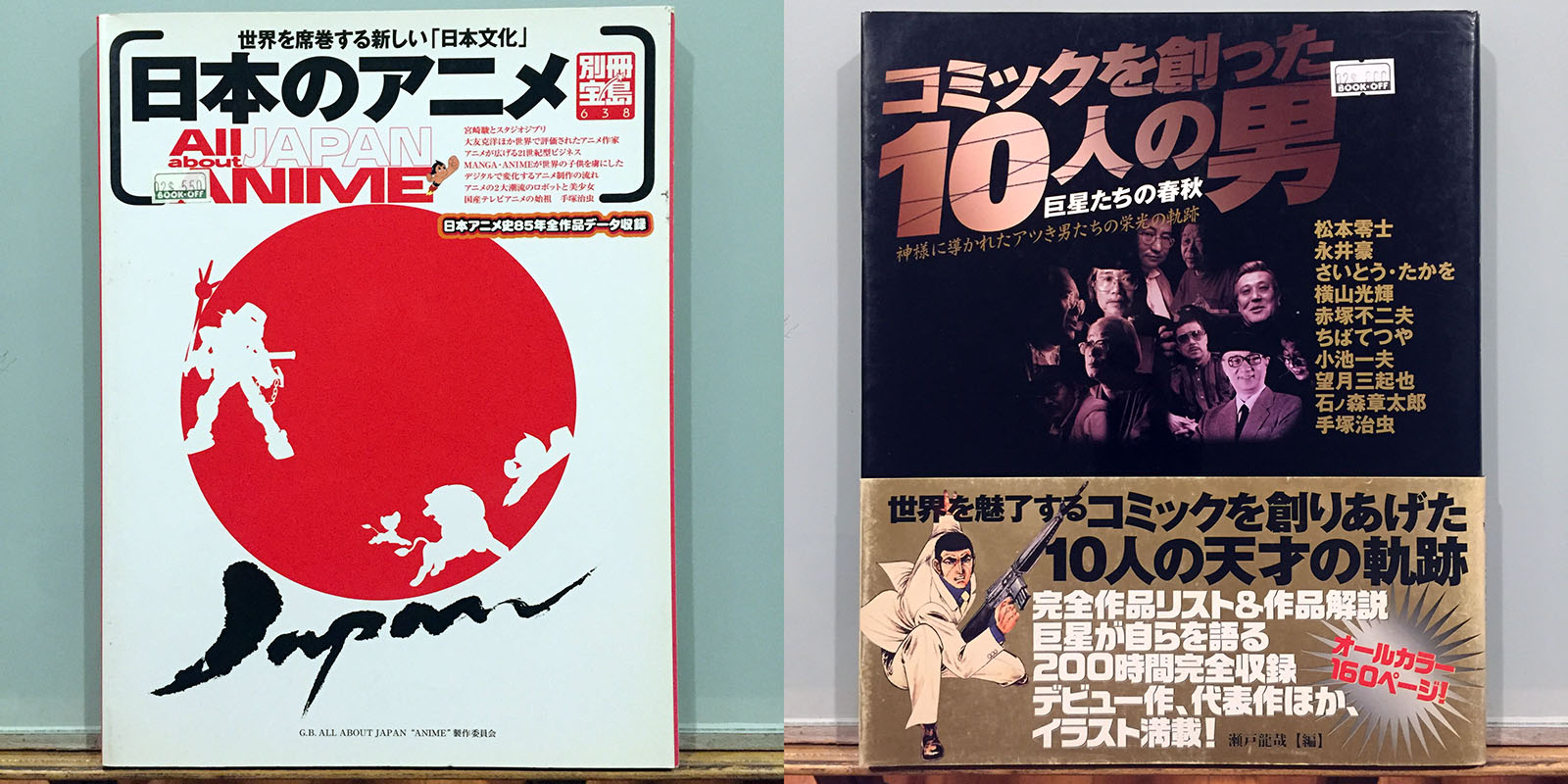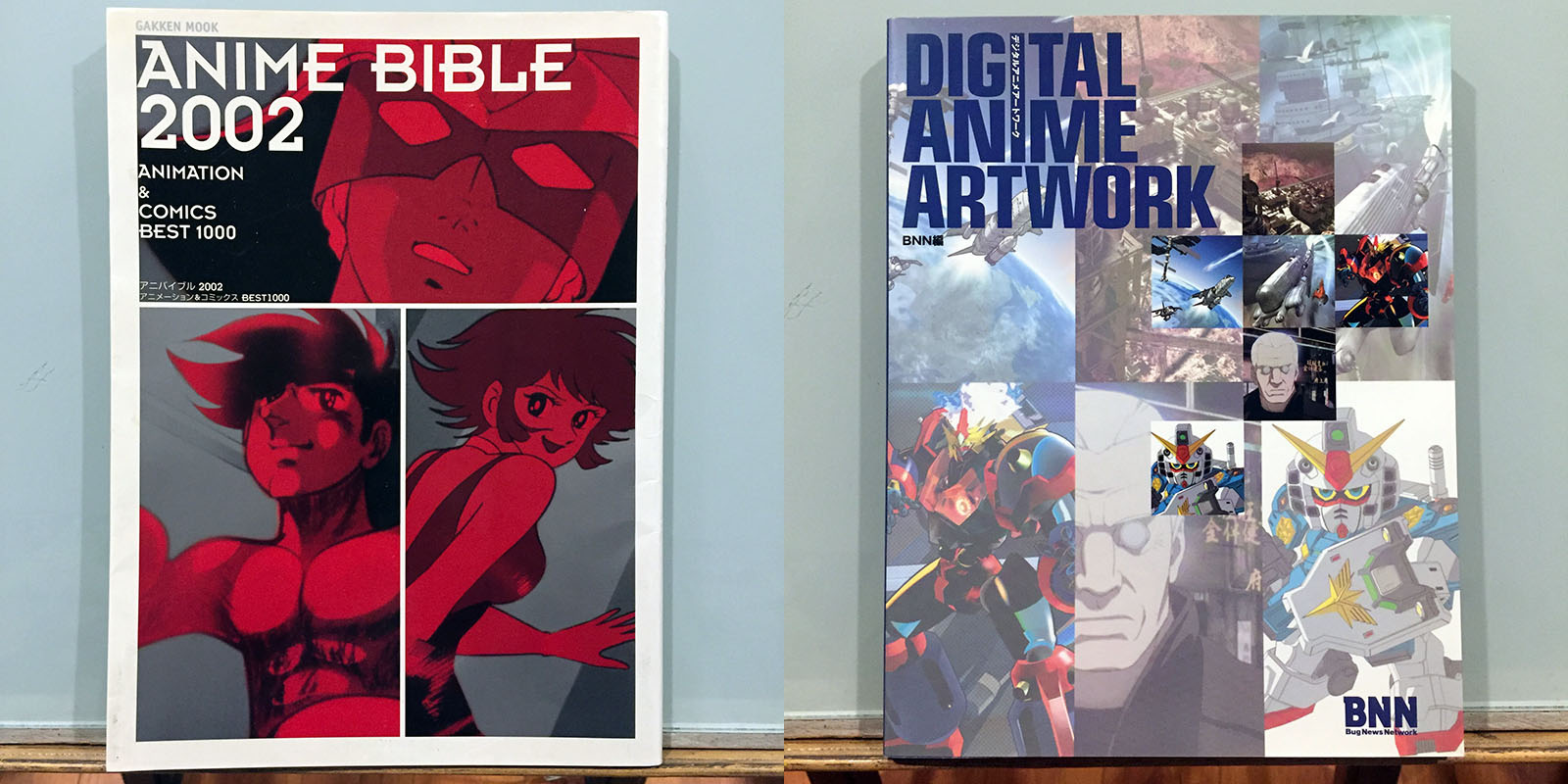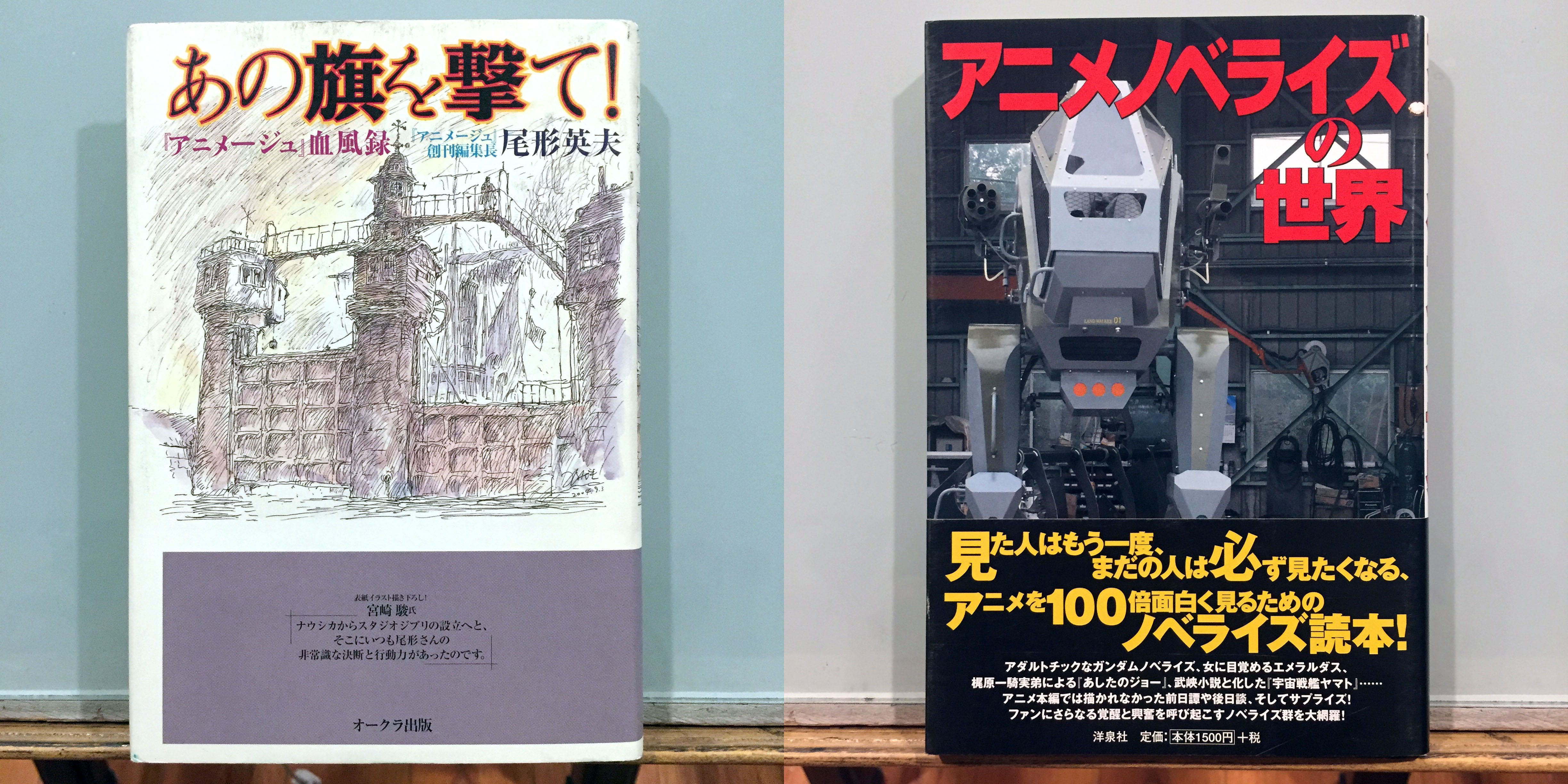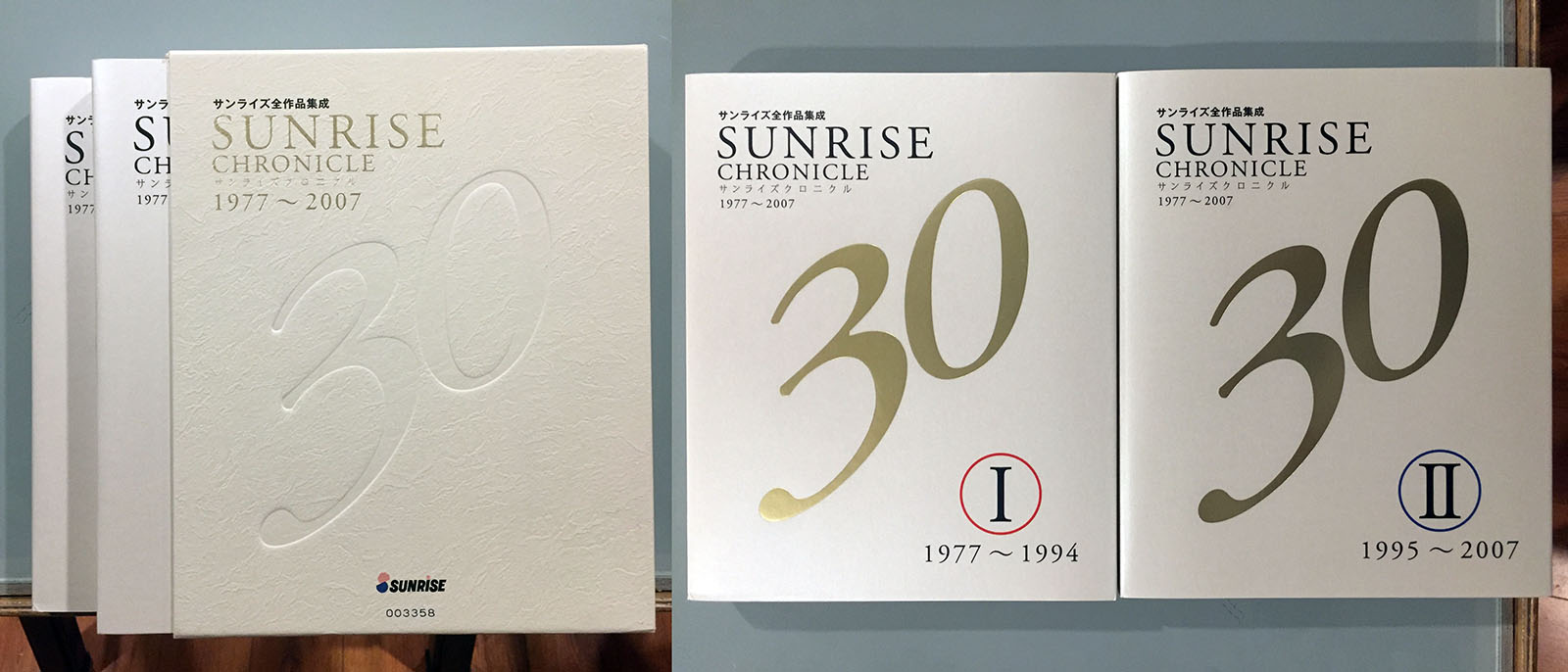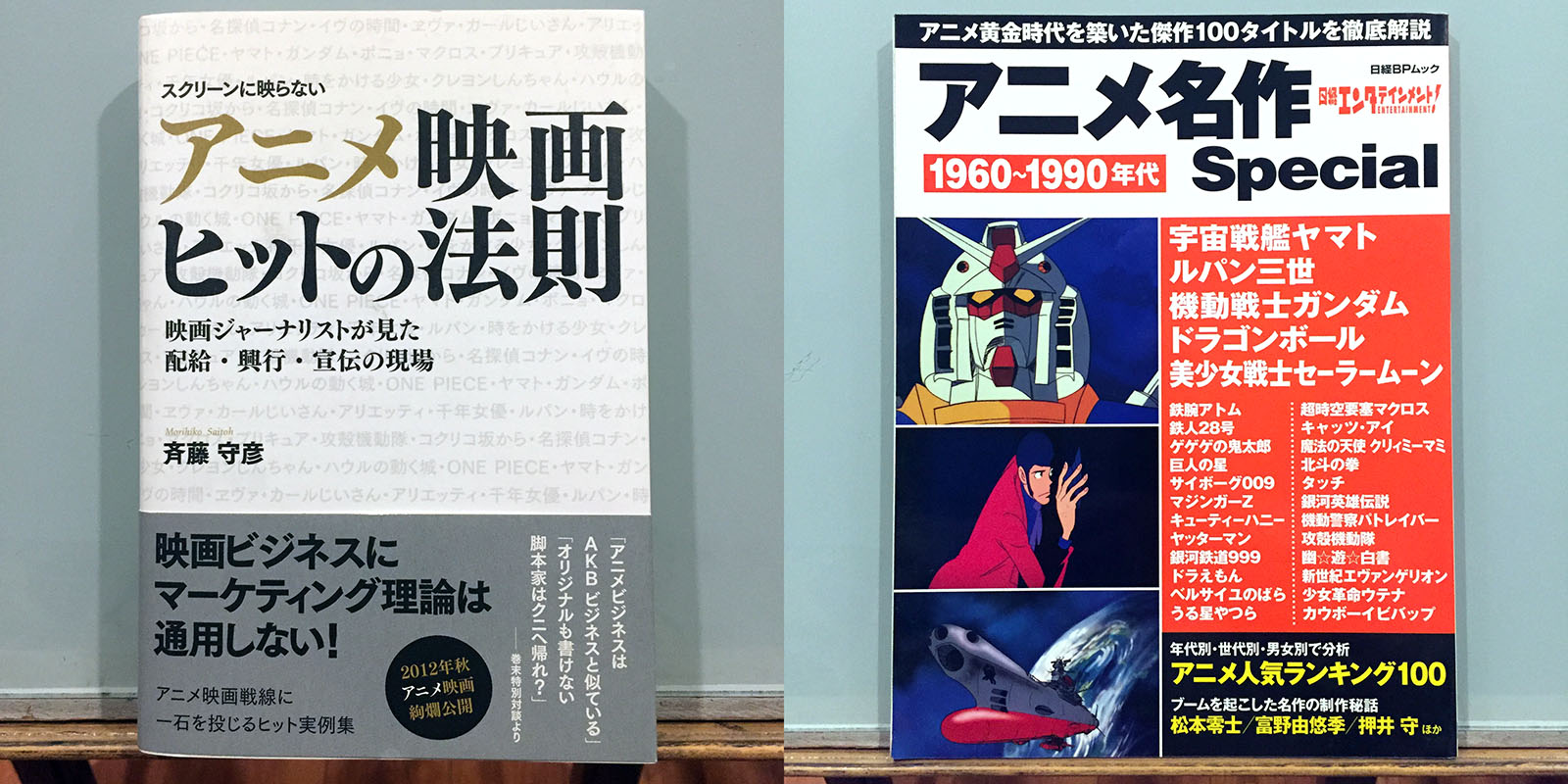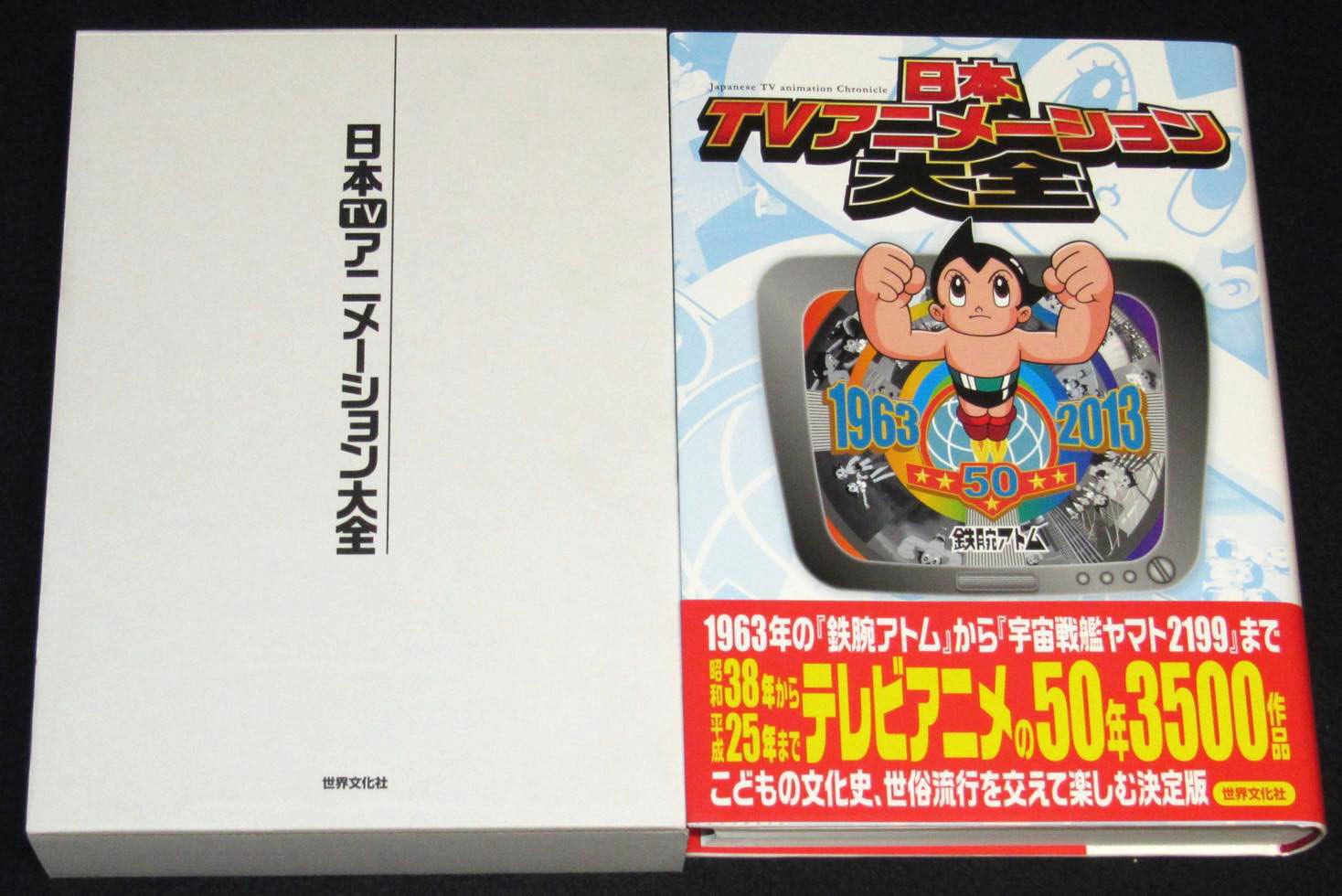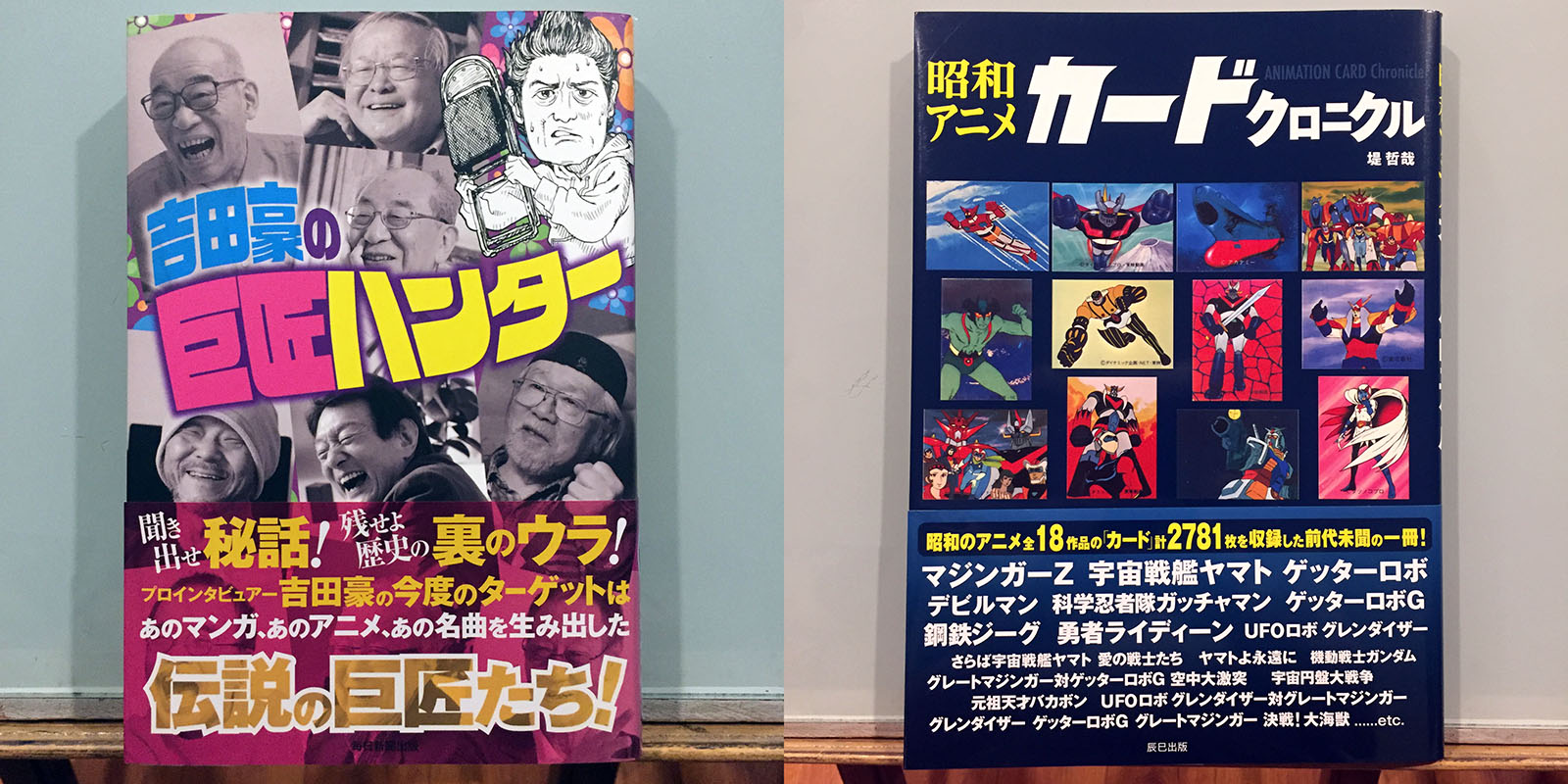Book Collection: Anime History & Research
When I became an anime fan in 1984/85, it seemed like the industry had pretty much organized itself. There were TV shows, movies, OVAs, and a huge publishing collective to keep tabs on it all. There were books and magazines aplenty to document past and present. What I didn’t know then was that these efforts had been underway for less than ten years.
Feature films got hot in the 50s and TV anime arrived in the early 60s, but it was still a children’s medium. Publishing was limited to children’s books based on cartoons they were expected to outgrow at ten years old. Any time someone tried to break out of that mold, they found no infrastructure to support them. The catalyst that finally changed that – and proved that kids would stick around after they turned ten – was the Space Battleship Yamato feature film in the milestone summer of 1977.
That’s when books started showing up for older readers. And the first order of business was to start documenting how everything reached that point. This went hand in hand with both manga and science-fiction, so it was quite common to see the subjects cross over. And when you had such information at your fingertips, the next logical point of inquiry was to find out who made the stuff you like. Seemingly overnight, a serious hunger for information and a publishing industry to provide it were born simultaneously.
Of course, any time you write about history, your end product becomes outdated as soon as it’s published, since time has a habit of not standing still. Thus, the well of data broadened and deepened year by year. I started collecting these books out of a desire to learn more about the medium, particularly so I could research and write articles for Cosmo DNA. I soon found that older books made great time capsules (not to mention collector guides), and it was fascinating to see how content and presentation styles grew along with the medium they covered.
These days, I don’t know if it’s possible any more to keep pace with the staggering output we see every single year. There was a time when you could comfortably contain an overview of every anime ever made between two covers, but books like that started to fade away around the end of the 20th century. Now it seems only an internet can handle the volume. But if you want to see how it was done in the days of ink and paper, here’s some of what awaits you. Japanese titles are included for search purposes.
The World of TV Anime
TVアニメの世界
Color and B&W, 214 pages
Dec 1977, Asahi Sonorama
If there’s an earlier book than this one, I haven’t found it yet. It’s quite a treasure, a spinoff of Manga Shonen magazine that offers much more than expected. Plus, it had only 14 years of TV anime to cover, so it could lavish attention on whatever it wanted. Included are scripts and picture stories of favorite episodes (Yamato, Cyborg 009, Gatchaman, and more), creator interviews, indexes of everything made for TV up to October ’77, articles on how anime is made, etc. A perfect introduction to a vibrant medium that was just starting to expand its reach.
SF Fantasia Vol. 1 Earth Edition
SFファンタジア 1 地上編
Color and B&W, 128 pages
1977, Gakken
The first of a seven-volume series that each examined different aspects of science-fiction, sampling broadly from Western and Eastern media alike. Heavily illustrated, they are a complete mishmash with a surprise on every page. This one was devoted to Earth-based SF films and novels up to 1977, a dystopian period with disasters around every corner. (Star Wars didn’t open in Japan until the following year, so the “renaissance” hadn’t happened yet.)
SF Fantasia Vol. 2 Space/Time Edition
SFファンタジア 2 時空編
Color and B&W, 128 pages
1977, Gakken
Space and time travel stories were the subject of volume 2, going all the way back to the early 20th century pulps and stretching forward to such fare as Space Battleship Yamato and Star Trek. Each volume also has a short standalone chapter of manga by a popular creator, in this case Leiji Matsumoto.
SF Fantasia Vol. 3 Other Worlds Edition
SFファンタジア 3 異世界編
Color and B&W, 136 pages
1978, Gakken
Other planets, other realms, other dimensions, other times. Anything goes. This was the first volume published after the Japanese premire of Star Wars, so an 8-page color addendum was hastily tipped into the back of the book to capture the growing sense of wonder.
SF Fantasia Vol. 4 Fantasy Edition
SFファンタジア 4 幻想編
Color and B&W, 128 pages
1978, Gakken
Folklore, fairy tales, myths and legends were the subject of this one, which is just as scrambled and delightful as you can imagine. With only the slenderest of organizing principles, the whole series just feels like a giant infodump to cram in as much as possible. It’s great.
SF Fantasia Vol. 5 Satire Edition
SFファンタジア 5 風刺編
Color and B&W, 140 pages
1978, Gakken
Satirical SF, and not the funny kind; the type of stories that hold up a mirror to modern society and refract it in order to reveal it. There are articles in every volume that presumably dive into the topic, but for the rest of us it’s a cornucopia of art and photography.
SF Fantasia Vol. 6 Manga Edition
SFファンタジア 6 マンガ編
Color and B&W, 128 pages
1979, Gakken
A Leiji Matsumoto cover will catch my eye every time. This was the volume that made me want to pick up the set and see what it was all about. And not a cent went to waste. The manga volume is a dense, colorful historical examination of Japan’s best, including an index that goes all the way back to 1930. Several pages are devoted to Western comics as well, but manga is the real star.
SF Fantasia Vol. 7 Art Edition
SFファンタジア 7 アート編
Color and B&W, 128 pages
1979, Gakken
A spectacular conclusion to a spectacular series, lavished with paintings and illustrations from all times and places. Includes a unique section of anime and SF mecha blueprints culled from various sources. These books are inevitably dated, but are so jam-packed with eclectica you wonder how anyone could have secured publishing rights to all of it. (Answer: it was probably cheaper back then.)
All About SF Space Movies
SF宇宙映画のすべて
Color and B&W, 126 pages
Jan 1978, Totosha
As the title implies, this is mostly a digest of SF movies from all over the world, mainly western countries. But Japan was just starting to add its own entries to the catalog with Space Battleship Yamato and The War in Space. Otherwise, this is a fun romp through a lot of well-worn titles with Star Wars just about to change everything.
SF Anime Fantasy
SFアニメファンタジー
Color and B&W, 136 pages
June 1978, Shinshokan
With Star Wars and the second Space Battleship Yamato movie just about to hit Japan, this book attempted to take in the whole context of SF and anime cinema, resulting in a fun grab bag of articles and features including a section on Walt Disney and another on European animation.
Terebi Anime Complete Collection 1, Mighty Atom to Attack No. 1
テレビアニメ全集 1
B&W, 220 pages
June 1978, Akimoto Shobo
This modest paperback was one of the first attempts to create a database for every TV anime series with production info, story synopses, etc. It covered the years 1963-1969, encompassing 77 titles.
Terebi Anime Complete Collection 2, Tomorrow’s Joe to Space Battleship Yamato
テレビアニメ全集 2
B&W, 220 pages
Sep 1978, Akimoto Shobo
A direct continuation, this volume covered 1970-1974, encompassing 80 titles. The presentation is no-frills, but the data is impeccable.
Terebi Anime Complete Collection 3
テレビアニメ全集 3
B&W, 308 pages
Apr 1979, Akimoto Shobo
The third volume in this series was the thickest, as good a symbol as any of the growing output. It contained specs and synopses for 102 different series broadcast from 1975-1978.
TV anime theme song collection
テレビアニメ主題歌集
B&W, 368 pages
Jan 1979, Akimoto Shobo
This companion volume was a text-only digest containing lyrics for hundreds of anime theme songs from the very beginning up to the end of 1978. No photos or stills. Just the thing to tuck into your pocket for a night of karaoke.
Fantastic Collection 8
World of SF Illustration, Studio Nue
ファンタスティックコレクション8
SFイラストの世界 スタジオぬえ
Color and B&W, 64 pages
Aug 1978, Asahi Sonorama
Studio Nue was the first shop to specialize in SF illustration and writing, a group of five self-proclaimed otaku (before the word existed) whose work was highly sought after in anime, film, and print media. This may be the earliest example of a studio-based art collection.
TV Anime Grand March
All Popular People Gather
テレビアニメ大行進•人気者全員集合
Color and B&W, 160 pages
Nov 1978, Shueisha
Anime was quickly expanding its reach beyond children, and with this expansion came more in-depth coverage. This book covered the entire production process, using materials from popular shows to explore how TV anime was made. It probably served as a valuable recruitment tool for those who were beginning to consider it as a career.
TV Anime Compendium, from Mighty Atom to Space Battleship Yamato
TVアニメ大全科
Color and B&W, 320 pages
March 1979, Akita Shobo
Created for younger readers, this thick paperback is organized by genre rather than a chronological database. As per the title, it ranges from 1963 to 1974.
TV Anime Compendium Part 2
The Latest TV Anime Heroes
TVアニメ大全科
Color and B&W, 310 pages
Oct 1979, Akita Shobo
With less material to cover than the first volume, this one is evenly split between a catalog of hero characters from 1979 and a guide to 124 popular voice actors.
Voice Actor & Animation Encyclopedia
声優&アニメーション大百科
Color and B&W, 274 pages
Sept 1979, Tokyo Sansei Co.
By 1979, voice actors were becoming as popular as the characters they played, and this book spent most of its pages profiling 106 of them with questionnaires and dossiers. About a quarter of the book was devoted to a study of anime production.
Animation ’80
アニメーション ’80
Color and B&W, 124 pages
April 1980, Shueisha
A showcase for anime feature films from early 1980, primarily Phoenix 2772 and Tomorrow’s Joe with a few others and some Disney titles being released in Japan. A few pages were devoted to contemporary TV anime along with an index of popular creators and their birthdays.
Otherworldly Fantasy Vol. 11
SF Anime Encyclopedia
SFアニメ大全科
Color and B&W, 256 pages
May 1980, Otherworldly Fantasy
A broad examination of SF anime and its context in world cinema. Contains interviews with prominent creators (including Keiko Tekyama, Leiji Matsumoto, and Osamu Tezuka), numerous articles on the state of the genre, extensive film lists from Japan and the rest of the world, and an index of 115 SF TV series up to early 1980.
TV Anime Frontline
17 Years of Anime History
テレビ・アニメ最前線 私説・アニメ17年史
B&W, 242 pages
July 1980, Daiwa Shobo
One of the earliest biographies by an anime director, Noboru Ishiguro. He started his career right at the beginning with Astro Boy, and went on to have key roles in such giants as Space Battleship Yamato. After the publication of this book, he directed Macross and many others. Read the Yamato chapter here.
Anime Poster Compendium
アニメポスター大全科
Color, 160 pages
Sept 1980, Akita Shobo
A terrific and extensive digest-sized catalog of images culled from theatrical posters, promotional flyers, and magazine foldouts. There’s no way of knowing how complete it is, but it covers just about everything I’ve heard of (and a lot of things I haven’t) from the 60s and 70s, and possibly earlier. Highly recommended.
Introduction to Anime
アニメなんでも入門
Color and B&W, 176 pages
June 1981, Shogakukan
This hardcover book spends a little time introducing popular anime titles, then dives into a breezy but in-depth illustrated tutorial in anime production. All parts of the process are covered, history is examined, and instructions are given for how to set up your own studio at home. There’s even an out-there prediction that one day anime will be made on computers.
Anime Masterpiece Collection
アニメ傑作コレクション
B&W, 208 pages
Aug 1981, Contract Publishing
The premise of this book is to curate 52 anime masterpieces (all movies) for you to watch, one per week over the course of a year. Most of the choices come from Japan, but some international titles are included. Also doubles as a handbook for superfans, advising on things to collect and where to find anime studios in Tokyo.
This is Animation 1
SF • Robot • Action Anime Edition
ジスイズアニメーション 1 SF・ロボット・アクションアニメ編
Color and B&W, 132 pages
April 1982, Shogakukan
The first of this 3-volume set took its title seriously. Instead of another catalog or encyclopedia, it examines in detail the art and craft of this specific genre set, interviewing some of the most popular creators in a variety of roles from writing to animating to mecha design and everything in between. One section investigates the dawn of computer animation, which was still in the vector graphics phase.
This is Animation 2
Fantasy • Fairy Tale • Girls Anime Edition
ジス・イズ・アニメーション2 ファンタジー・メルヘン・少女アニメ編
Color and B&W, 132 pages
June 1982, Shogakukan
SF and action anime flew across the ocean first, but it was only one of many genres that had been in the picture right from the beginning. This volume turns its attention to some of those with the same depth as volume 1 (talking with some of the same creators), revealing that they required an equal amount of effort and craftsmanship despite their more simplistic look.
This is Animation 3
Sports • Gag • Life Anime Edition
ジス・イズ・アニメーション3 スポーツ・ギャグ・生活アニメ編
Color and B&W, 132 pages
Aug 1982, Shogakukan
The band played on with this volume, dedicated to anime most western audiences never heard of, but were staples in Japan and took just as much ingenuity to create. Many highlights in this one, including a very rare index of all the anime titles made in the pre-TV decades from 1917 to 1963.
TV Anime Compendium Part 3
TVアニメ大全科
Color and B&W, 288 pages
July 1982, Akita Shobo
A digest of the many TV series and specials broadcast in the two and a half years since the previous volume.
I Love Anime! From Yamato to Gundam
アニメ大好き! ヤマトからガンダムへ
Color and B&W, 250 pages
Nov 1982, Tokuma Shoten
As suggested by the title, this is an extended love letter to the entire world of anime as told from a fan’s perspective. The author Noriaki Ikeda chronicles the rising popularity of anime and the explosive trends that turned it into a phenomenon. In addition to the industry, he also examines how the powerful engine of fan activity helped push everything forward. (He wrote many other pop culture books and later became an anime producer for Kadokawa.) Read the Space Battleship Yamato chapters here.
This is Animation
Animation Yearbook 1983
THIS IS ANIMATION アニメーション年鑑 1983
B&W with some color, 408 pages
August 1983, Shokagukan
This is Animation
Animation Yearbook 1984
THIS IS ANIMATION アニメーション年鑑 1984
B&W with some color, 406 pages
September 1984, Shokagukan
These satisfyingly thick tomes served as “anime almanacs” for two years running with essays about the industry and overviews of every single TV episode, special, and film within a specified range. The range for the first volume was April 1982 to May 1983, and the second picked up from there through March 1984. The effort to assemble the incredible amount of data for these books is as likely an explanation as any for why they didn’t continue.
It’s Artland
イッツ アートランド
Color and B&W, 144 pages
Dec 1983, Sougeisha
A self-published “jam project” by the artists of Noboru Ishiguro’s Artland studio, which served as the animation hub for Macross and many other well-known SF titles (Ishiguro is no longer with us, but Artland is still operating today). Illustrations, manga, and articles about the daily grind in the anime trenches make it a unique package.
TV Anime Compendium Part 4
TVアニメ大全科
Color and B&W, 288 pages
Oct 1986, Akita Shobo
Organized by year, this fourth volume covered all the TV anime series and specials broadcast in 1982 and 1983, a total of 84 titles. Also includes a complete list of episode titles.
TV Anime Compendium Part 5
TVアニメ大全科
Color and B&W, 288 pages
Dec 1986, Akita Shobo
The last volume of the series covered TV series and specials broadcast from the beginning of 1984 through part of 1986, a total of 80 titles.
Artmic Design Works
アートミックデザインワークス
Color and B&W, 160 pages
Oct 1987, Bandai
The 80s saw huge technical leaps forward in anime quality, and Artmic was one of the powerhouses that drove it with one hit after another (Mospeada, Megazone 23, Gall Force, Bubblegum Crisis, and many others). This book rounds up their cutting-edge design work for not just anime titles, but relevant merchandising and a few western productions as well. A fantastic and colorful time capsule of a flashpoint in anime history.
The Art of Japanese Animation I
25 Years of Television Cartoons
TVアニメ25年史
Color, 192 pages
Dec 1988, Tokuma Shoten
This wasn’t quite “the art of” anything, but as accessible indexes go, this is as good as it gets; every single anime TV series from 1963 to October 1988, a total of 668 titles at this point. One photo each with production data and a synopsis, curated by the makers of Animage magazine.
The Art of Japanese Animation II
70 Years of Theatrical Films
劇場アニメ70年史
Color, 168 pages
Jan 1989, Tokuma Shoten
The surprising thing about this book was its title. Few western fans knew at the time that anime started showing up in movie theaters as early as 1917, and there were already 126 documented titles before the first color film arrived in 1957. A total of 468 films are documented here, followed by an impressive set of investigative articles.
Animation Video Collector’s Guide
(Anime Video ’89 Catalog)
アニメビデオ ’89 カタログ
Color and B&W, 186 pages
March 1989, Genkosha
Monthly anime magazines did their part to track and organize data on direct-to-video OVA titles, but this was the first book (that I know of) to tackle the subject. In addition to a “best 50” ranking, it includes a handful of creator interviews and a dense, all-text index of close to 2,000 individual titles in this category – an astonishing output for a format that had only been around for six years.
Studio Nue Mechanic Design Book Part 1
Mobile Weapons Edition
Entertainment Bible
スタジオぬえ メカニックデザインブック (1)機動兵器編
Color and B&W, 194 pages
Oct 1989, Bandai
Studio Nue only picked up more steam in the time since their 1978 art collection was published. Now they could fill up this 2-volume digest set with ease. The first volume compiled their revolutionary designs for robots, flying vehicles, ground vehicles, and technical illustration.
Studio Nue Mechanic Design Book Part 2
Space Battleship edition
Entertainment Bible
スタジオぬえ メカニックデザインブック (2)宇宙戦艦編
Color and B&W, 194 pages
March 1990, Bandai
The second volume was jam-packed with spaceship designs from anime and film, followed up by original illustrated essays called the “Studio Nue Starship Library.” From here, the studio’s output became so prodigious and respected that the individual artists would get their own books.
Tatsunoko Anniversary
(Tatsunoko Pro 30th Anniversary Collection)
タツノコプロ30周年記念全集
Film book: Color and B&W, 192 pages • Sketch book: Color, 112 pages
1993, Bandai
As major studios hit their anniversaries, deluxe commemorative books like this would appear. Tatsunoko’s version consisted of two books in a slipcase. The “Film book” covers all their anime productions from 1965 to 1992 with a comprehensive index and a grab-bag of products, design documents, interviews, and more. The “Sketch book” is a curated collection of color concept art by the studio’s leading character designers.
Comix Climax, Special Moves Edition
コミックスクライマックス 必殺技編
B&W, 274 pages
Feb 1996, Take Shobo
Sidestepping into the parallel world of manga, we find books like this one, which rounded up pivotal chapters from six different SF or action titles and augmented them with commentary. When you’re overwhelmed by the world of anime, it’s easy to forget that manga is an even bigger industry, and most of what we love begins there.
This Manga is Amazing!
このマンガがすごい!
B&W, 256 pages
May 1996, Takarajima
Faced with such a huge medium, it can be tough to know where to begin. This book comes to the rescue by sorting over a thousand manga titles into a staggering 83 different sub-genres with recommended titles to read. Maybe someday the US comics industry will reach such a milestone.
Interesting SF Anime
SFアニメがおもしろい
B&W, 192 pages
Jan 1997, Aspect
Obsessively researched, this in-depth book examines not just SF anime titles, but the business of making them, the labyrinth of production companies, and the many-layered machinery of merchandising. It’s informative and fun with articles on dream mecha match-ups, a unified calendar of story events, creator commentaries, superfan recommendations, unique illustrations, manga, and a lot more.
This Anime is Amazing!
From Mighty Atom to Evangelion
このアニメがすごい!
Color and B&W, 240 pages
Jan 1997, Takarajima
A general overview of the anime business with articles, interviews, and analysis. Includes a large section that recommends the 100 best anime to watch, spread out over seven genres.
Find the best manga in Japan!
日本一のマンガを探せ!
B&W, 320 pages
June 1997, Takarajima
They’re not kidding around now. This book starts by mapping out a spectrum to determine what kind of stories you like, then offers up a whopping 2,000 titles that land on various parts of that spectrum. Support articles also help you to consider your options.
A book that will change the way you look at anime
アニメの見方が変わる本
Color and B&W, 272 pages
Sept 1997, Takarajima
If you’re not yet willing to watch some anime on TV, but are somehow still open to reading a thick book about it instead, this one is for you. Contains heavy-duty analysis on the various categories of anime available to viewers, augmented by creator interviews and personal testimonials. If you can’t be convinced to watch something after you’ve read this book, I guess there’s no hope for you. Go turn on the golf channel.
Sunrise Anime Super Data File
(The Complete History of Sunrise Anime)
サンライズアニメ大全史
Color and B&W, 160 pages
Oct 1997, Tatsumi Publishing
A pleasantly thick catalog of every Sunrise production, which just happened to land on the studio’s 20th anniversary. Covers everything made in that time, organized into TV, film, and OVA categories with lots of creator interviews and many pages (though not nearly enough) on merchandising and collectibles. Highly recommended.
Tatsunoko Pro Anime Super Data File
(The Complete History of Tatsunoko Pro Anime)
タツノコプロアニメ大全史
Color and B&W, 160 pages
Feb 1998, Tatsumi Mook
This one is only 30 pages slimmer than the 30th Anniversary film book published five years earlier, but jams in even more information that makes it a joy to flip through. There’s a party on every page, and you’re invited!
An Introduction to the Historical Study of Japanese Animation
日本アニメ史学研究序説
B&W, 210 pages
Feb 1998, Yawata Shobo
Mainly text, an exploration that puts major titles and industry trends into a historical context. Includes a complete index of all movies and TV anime made since 1958.
Motion Picture King Vol. 4
動画王 Vol. 4
B&W, 274 pages
March 1998, Kinema Junpo
Split roughly down the middle between anime and live-action, this special issue of a biweekly movie magazine attempts to catalog nearly every story of Earth in peril, either from aliens or war among humans. Mostly text with cartoons and stills.
Best of Animage 20th Anniversary
Best of アニメージュ 20th Anniversary アニメ20年史
Color and B&W, 186 pages
Aug 1998, Tokuma Shoten
Animage debuted in the summer ’78 Yamato boom and soon became the leading monthly anime magazine, outlasting many competitors and eventually becoming a production partner for feature films. This book touches on all the highlights of its first twenty years, serving as both an overview and a back-issue guide for collectors. Also includes interviews and retrospectives on what it took to keep the engine running.
221 Immortal Masterpieces, Super A-class Animation “Impression” Theater
不朽の名作221本 超A級アニメーション”感動”劇場
Color and B&W, 160 pages
1998, Shufu & Seikatsu Co.
A respectable effort to chart an increasingly unchartable world of anime productions. Divided into five parts: Studio Ghibli productions, creator interviews, Gundam and robot anime, recommended titles, and “world masterpieces” (adapted from literary works).
Animation International Chronicle
(History of AIC’s 15th anniversary)
AIC創立15周年記録大全史
Color and B&W, 160 pages
July 1999, Media Works
AIC Studio got its start thanks to the OVA boom of the mid 80s, and it quickly grew into a huge, energetic company with a prodigious number of productions (including many adult titles). This book puts all of them between two covers, along with creator interviews, merchandising, and art collections.
Tokyo Movie Anime Super Data File
(The Complete History of Tokyo Movie Animation)
東京ムービーアニメ大全史
Color and B&W, 176 pages
Aug 1999, Tatsumi Publishing
Tokyo Movie is another big studio that got its start in the early days of TV anime, all the way back in 1964. This book recounts their first 35 years in the same way the previous Super Data File books did for Sunrise and Tatsunoko, making it a satisfying browse.
All About Japan Anime
別冊宝島 日本のアニメ
Color and B&W, 194 pages
April 2002, Takarajima Mook 638
This is one of those books that really, really needs an English edition; beautifully designed and carefully constructed to communicate the depth and vastness of the entire anime industry with a huge range of illustrated articles, interviews, histories, and recommendations. Also includes a year-by-year production chart from 1963 onward that perfectly maps out the explosive phenomenon.
Ten Men Who Made Comics
コミックを創った10人の男
Color, 160 pages
May 2002, Wani Books
Exactly what it sounds like: ten of the most prominent manga artist in Japan, each given their own profile chapter. Generously illustrated with comic art and merchandising, along with analysis and bibliographies. It offers especially good insight into creators you may not be familiar with.
Anime Bible 2002: Animation & Comics Best 1000
アニメバイブル 2002 ― アニメーション & コミックス
Color, 175 pages
Aug 2002, Gakken
A densely-packed compendium of 1000 titles broken up into multiple categories: best 200 anime titles, best 100 heroes, best 100 heroines, best 100 mecha, best 200 manga titles, best 100 non-Japanese cartoons & comics, and best 200 anime creators. They’re all presented in chronological order so as not to get caught up in a ranking war, but inevitably a presentation like this is just a means of validating your own choices. The real value is in the latter third, which includes year-by-year charts from 1963 to early 2002 that map every single anime production in every format. The book is worth the price for that alone.
Digital Anime Artwork
デジタルアニメアートワーク
Color, 240 pages
Oct 2004, Bug News Network
Ironically, Japan was slower to adapt CG into anime, but once the techniques were fully embraced they took off like nowhere else in the world. This book is mostly a how-to, using prominent productions as examples.
Shoot That Flag!
Animage Blood Wind Record
あの旗を撃て!―『アニメージュ』血風録
B&W, 328 pages
Nov 2004, Okura Publishing
As the mastermind behind Animage magazine, Hideo Ogata played an instrumental role in building the foundation of anime culture. In 2004, three years before he lost a fight with cancer, he did the world a huge favor by publishing his memoirs. Read two chapters in English here
The World of Anime Novelize
アニメノベライズの世界
B&W, 224 pages
July 2006, Hiroshi Spring
Anime novels have been around since the start, either adapting a favorite title or adding new dimensions to it. This book curates and examines 100 different novel titles, analyzing the value they bring to their subject.
Sunrise Chronicle 1977-2007
サンライズクロニクル
Book 1: Color, 368 pages • Book 2: Color, 354 pages
Dec 2007, Sunrise
Sunrise is the biggest, most lucrative anime studio in Japan (actually, a network of several studios under one name), and when they hit their 30th anniversary, only the biggest tribute would do. This set consists of two very thick books that lavish attention on every single production (hundreds of them by this time) in chronological order.
The Law of Anime Hit Movies
A film journalist’s view of distribution, box office, and advertising
アニメ映画ヒットの法則
映画ジャーナリストが見た配給・興行・宣伝の現場 スクリーンに映らない
B&W, 256 pages
Oct 2012, Knowledge Base Publishing
A collection of lengthy articles by respected film journalist Morihiko Saito (1961-2017) that explore the genesis, distribution, promotion, and box office performances of popular anime feature films. It’s all text, but you can read the Space Battleship Yamato chapter in English here.
Nikkei Entertainment
Anime Masterpiece Special
日経エンタテインメント アニメ名作 Special
Color, 106 pages
Aug 2014, Nikkei Business Publications
This one is somewhat lightweight compared to other entries on this page, but it’s a pretty succinct summation of the biggest hits and franchises from the 60s through the 90s (carrying over into the 21st century). Also includes a section on anime songmaking, which is rarer than it should be.
Japan TV Animation Encyclopedia, 50th Anniversary of TV Animation
日本TVアニメーション大全 テレビアニメ50年記念
Color, 720 pages
Dec 2014, Sekai Bunka (World Culture Publishing)
Comparing this massive tome to Tokuma Shoten’s 25 Years of Television Cartoons from 1988 reveals a staggering figure. At the 25th year of anime on TV, 668 titles had been produced. Jump forward to the 50th year, and the figure is now an overwhelming 3,500. In other words, just over 80% of the total output took place in the second half of those 50 years. This is the sort of thing you learn when books like this map it out for you.
Go Yoshida’s Master Hunter
吉田豪の巨匠ハンター
B&W, 320 pages
March 2020, Mainichi Shimbun Publishing Co.
Go Yoshida, a professional interviewer across all media, is particularly adept at getting candid conversations from his subjects. This unusual book is a treasure trove of his interviews with some of Japan’s top anime luminaries from Leiji Matsumoto to Yoshiyuki Tomino. Read his interview with Yoshikazu Yasuhiko here.
Showa Anime Card Chronicle
昭和アニメカードクロニクル
Color, 160 pages
March 2021, Tatsumi Publishing
Before on-demand viewing was even a dream, kids had collectible mini-cards to chase down with stills from their favorite anime. This full color catalog collects over 2,700 mini-cards from 18 different 1970s anime shows. It’s still in print, so order it here!

